Entertainment

How do 'Interstellar' Characters age?
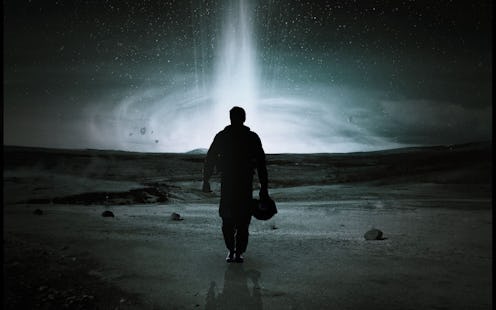
(Warning: The following contains major spoilers regarding plot points in Interstellar .) While Interstellar is perfectly enjoyable on its own accord, a bit of homework might be necessary to fully understand and appreciate all the tenets of science fiction woven throughout. Questions amount as we watch Matthew McConaughey blast through a wormhole to the other side of the universe, spend an hour on an alien planet that amounts to seven years on Earth time, and take one fateful journey inside the most mysterious of constructs in known science: the black hole.
Since the Nolan brothers’ dry-as-store-brand-Matzo exposition can be tough to permeate at times, it doesn’t hurt to brave some extracurricular research into the aforementioned concepts. Just in case David’s index card diagram, Wes Bentley mathematical estimates, and a trippy montage of dark blurs and white specks didn’t clear things up for you, here are some broad strokes explanations of each of the sci-fi concepts entertained in Interstellar and how and why they had the effect that they did on the characters.
(Note: In the spirit of Interstellar , I wholly endorse eschewing all scientific explanation of light, time, space travel, gravity, wormholes, black holes, et al in lieu of the simple, “It’s all about love.”)
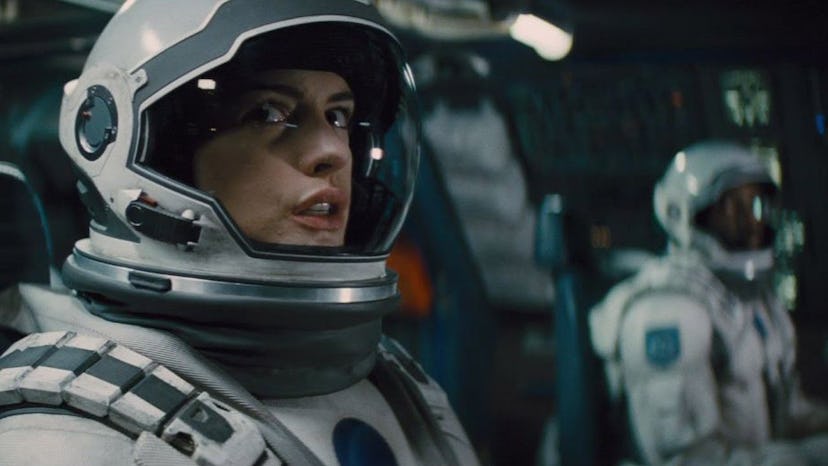
Though wormholes are probably the easiest of Interstellar ’s sci-fi concepts to grasp. You find a wormhole in outer space — in the case of the film, right outside the rings of Saturn. You enter. You come out the other side in a different place entirely — another point in space, one that may have taken you years, centuries, eons to reach via traditional travel.
Simple enough to imagine, but it’s the physical illustration of the wormhole that is a little more complicated. If you take a step outside of the universe (just for a second, I’ll save your seat) and view the whole thing head-on as a tangible substance — for the purposes of this explanation, a thick fabric might be most conducive to easy visualization. Identify one point in/on the fabricverse. Now find another one, with miles and miles of sweet velour separating the pair.
Now, there are two ways to get from point A to point B — one: you can hoof it, but the universe is less permitting to this style of travel than a textile scale model might be. So go for option two: pick up the felt surrounding A, ditto that around B, and bring the two points together so that they touch. To the tiny denizens of your makeshift universe, nothing will have seemed to change… until you poke a hole straight through the unified points, connecting them via quick leap through this veritable tear in the universal material.
A personal favorite analogy: Mario Kart 64. Everybody knows that there’s a secret shortcut in the Wario Stadium level of Mario 64 that allows you to jump directly from one part of the course to another. Well, a wormhole is kind of like that. (Hey, it helps me.)
RELATIVE TIME

There are two mentions in Interstellar of specific conditions that render time “slower.” The first, as described by McConaughey to his weeping daughter in a misguided effort to comfort her, involves an observer traveling near the speed of light. First off, this doesn’t mean that time feels or appears any slower to the traveler in question — to him or her, the minutes, hours, or days would pass normally during travel; once the traveler slows down, however, he or she will notice that far more time has passed for those of us ambling about slowly. In short, the hot rod in question might have only felt a few days pass (and will have aged only as such), but would recognize years to have gone by for friends and family members, all of whom would be accordingly older.
Here’s why: Light is essentially our gateway into all comprehension of the universe and everything that happens therein. All conceivable information — everything we see and experience — is dictated to us by light. As such, imagine that light is an impossibly chatty friend explaining the details of a movie about your life to you over the phone: “Okay, so, right now, you’re sitting in your office. You’re reading a long-winded article about Interstellar . You’re blinking. You’re wondering how long you can go without blinking.” Every inconsequential detail is reported to you by this friend of yours, so you can only experience the movie as fast as your friend will recite its story. Furthermore (and this is an important detail), you are so enrapt in the description of this film that it seems like nothing else exists outside of your conversation.
And light is a dutiful friend — one who speaks quickly and constantly. In fact, since your entire understanding of everything and anything that might be happening in the universe/your incredibly boring biopic relies entirely on light’s narration, and there are no windows to the world outside of your own experiences under the regime of light/your endless phone call that it seems like light is always moving at a speed with a consistent distance from your own.
Light is also a bit of a showboat, never letting you think you’re closing in on its verbal illustrations in any way. In other words, no matter how fast you travel, light always seems to be traveling the same amount faster than you are. So, you can begin jogging, or sprinting, or piloting jets, or flying rockets at impossible speeds, but light will always seem to be zooming by as it always has. You can never “catch up” to light, or even gain on it. (Or so it seems.)
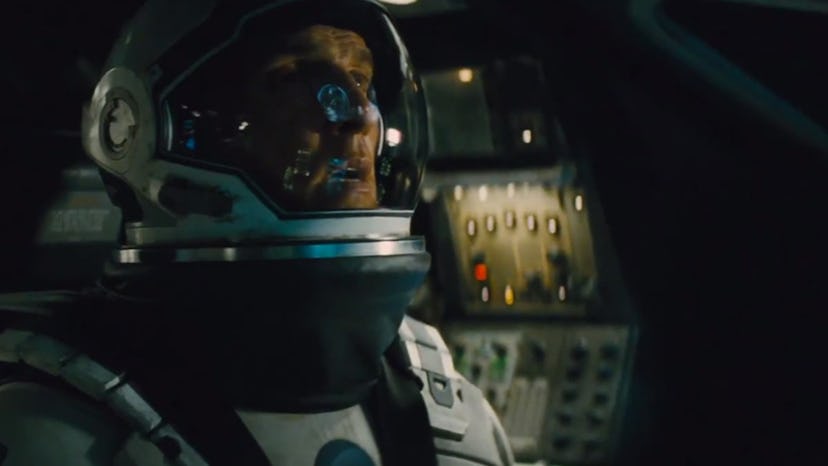
But give it a try and you’ll notice an oddity upon your return to normal speed. When traveling near the speed of light, you’ll feel yourself covering so much ground in so little time, blasting almost instantaneously from one point to an incredibly distant destination. But the casual observer won’t be able to see you reach your goal until light permits.
This is when that phone call metaphor comes back into play. No matter what some may deem “objective reality,” the only gateway of the whats and whens and wheres of the universe that your have is your chatty narrator, light. You can only see yourself reaching the finish line when light tells you such as happened; on the same token, your friends can only see you crossing the finish line when their respective narrators clue them into the happening.
But while you were traveling so fast as to, again, cover so much ground in so little time, your friends were patiently waiting for their perceptions of light to catch up. As you were traveling so much closer to the speed of light than any of them were, all light got a chance to show you was a quick race from one point to another. But back at normal speeds, far away from that of light, your friends got to see plenty more: light showed them all sorts of things in the interim period; it had more time to do so, since they weren’t riding its tail and pressuring it to stay on point. Time managed to show your friends a few hours worth of their lives; yours only showed you a few seconds.
Now, apply this on a grander scale: years to days, decades to weeks. We see this phenomenon take place in Interstellar when McConaughey and co approach the vicinity of a black hole — the second means by which relative time comes into discussion in the movie. Considering everything mentioned above about light’s dictation of all time and space, this one should be a quick explanation.
Heavy things are a pain in the ass to deal with. Picture the fabricverse from the wormhole passage again: light has to travel along this fabric to bring you the lot of your informational intake. But when there’s a tremendously heavy object sitting on the colossal fabric, light has to slink down into the resultant grooves and then skulk back up again just to reach you on the other side. A black hole is basically the biggest, heaviest, most obnoxiously intrusive object that can delay light’s progress. For all of the reasons explained prior, this delay of light results in a slowed passage of time in relation to those experiencing light and life outside of the black hole’s immediate neighborhood. As such, McConaughey’s trip to the outer banks of the dark nightmare costs him a whole lot of Earth years for just a few precious black hole hours.
BLACK HOLES
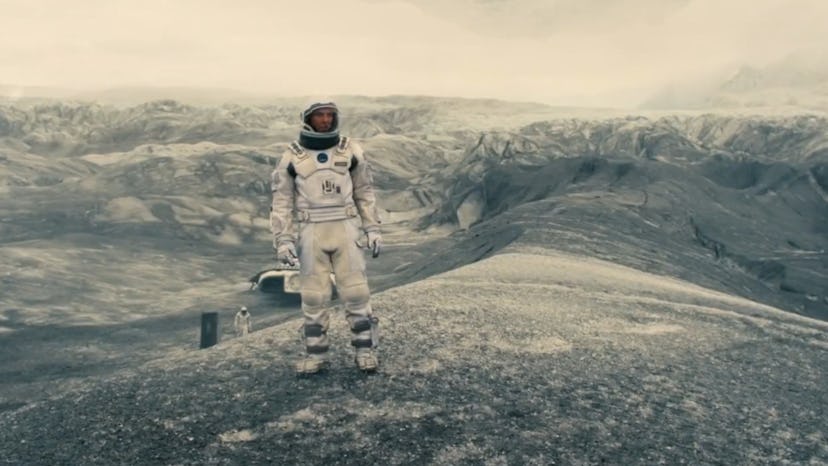
So what is a black hole? A theoretical doozy, for one. Basically, a black hole is the utmost pull of gravity in the universe: nothing can escape a black hole’s grasp, not even light (imagine light being too heavy for something, go figure). While this might not seem like a significant entity in a vacuum, the implications of a plane with no perceivable light — or a perception of light that we, as a race that cannot see inside a black hole, have never observed — are vast. As mentioned, light dictates time, life, everything. So what can exist inside a field where time, life, and everything are not dictated?
That is the question.
Images: Paramount Pictures (5)
- Screenwriting \e607
- Directing \e606
- Cinematography & Cameras \e605
- Editing & Post-Production \e602
- Documentary \e603
- Movies & TV \e60a
- Producing \e608
- Distribution & Marketing \e604
- Festivals & Events \e611
- Fundraising & Crowdfunding \e60f
- Sound & Music \e601
- Games & Transmedia \e60e
- Grants, Contests, & Awards \e60d
- Film School \e610
- Marketplace & Deals \e60b
- Off Topic \e609
- This Site \e600
'Interstellar' Explained: Timeline, Ending, Themes, and Meaning
Get ready to travel through time and space with christopher nolan..
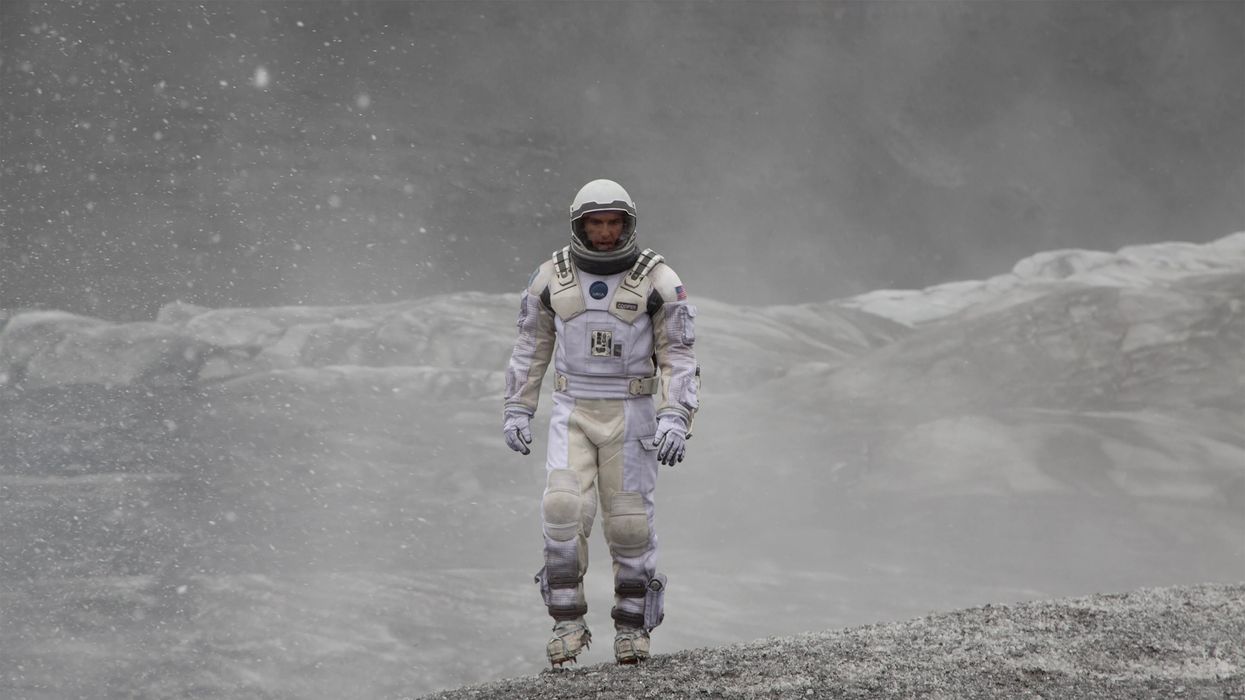
Interstellar is loud, sentimental, and filled with advanced scientific theories that work for the story, but are mostly theoretical in real life. I'm not one of those people who sit down to pluck apart the scientific plausibility of a screenplay unless I think it takes away from the story. In the case of Interstellar , I think it adds to it.
Interstellar juggles many different timeframes for the story. We cross from what's going on within Earth to the surface level of foreign planets, to the circling ship, and then to a fifth dimension that unites all of them. That's a lot to explain, so we're going to try to do it together.
Today, I want to get into the meaning and explanation for the movie Interstellar and even go over what happens in the movie. We'll talk about Jonathan Nolan and Christopher Nolan working on the movie together and examine its ongoing themes. I'm excited to dive into this one.
So let's get started.
The Interstellar Movie: Explained
Christopher Nolan is one of the most interesting directors out there. He tackles huge concepts and doesn't dumb them down. A lot of times the audience is working to learn along with the characters, and on the edge of our seats as certain plot points jump out. Let's go through the summary of Interstellar and then tackle explaining the movie and the Interstellar premise.
The Interstellar movie characters
- Matthew McConaughey as Joseph Cooper, a widower and NASA pilot who became a farmer.
- Anne Hathaway as Dr. Amelia Brand, a NASA scientist, and astronaut
- Mackenzie Foy as young Murph
- Ellen Burstyn as old Murph
- John Lithgow as Donald, Cooper's elderly father-in-law
- Michael Caine as Professor John Brand, a high-ranking NASA scientist, ideator of Plan A, former mentor of Cooper, and father of Amelia
- David Gyasi as Romilly, another high-ranking NASA member, and Endurance crew member
- Wes Bentley as Doyle, a high-ranking NASA member, and Endurance crew member
- Timothée Chalamet as young Tom
- Matt Damon as Mann, a NASA astronaut sent to an icy planet during the Lazarus program
- Bill Irwin as TARS (voice and puppetry) and CASE (puppetry)
- Josh Stewart as CASE (voice)
- Topher Grace as Getty, Murph's colleague and love interest
- Leah Cairns as Lois, Tom's wife
- David Oyelowo as School Principal
- Collette Wolfe as Ms. Hanley
- William Devane as Williams, another NASA member
- Elyes Gabel as Administrator
- Jeff Hephner as Doctor
- Russ Fega as Crew Chief
Interstellar plot and summary
The year is 2067, and crop shortages and dust storms have devastated humanity. We meet Cooper, a widower, engineer, and former NASA pilot. Now he’s a mediocre farmer. He and his two kids live with his father-in-law, Donald. His kids are the teenage son, Tom, and his 10-year-old daughter, Murph.
A terrible dust storm leaves a pattern on Murph's bedroom floor. Murph thinks a ghost created them, but the scientific-minded Cooper realizes the patterns were made by gravity variations. After some math, he thinks they represent geographic coordinates in binary code. Cooper and Murph follow the coordinates to a secret NASA facility headed by Professor John Brand, whom Cooper knows from his past life working at NASA.
The NASA scientists fill them in on what’s been going on. Forty-eight years ago, unknown beings placed a wormhole near Saturn, opening a path to a distant galaxy with 12 potentially habitable worlds located near a supermassive black hole named Gargantua. Twelve volunteers traveled through the wormhole to survey the planets, and three—Dr. Mann, Laura Miller, and Wolf Edmunds—reported positive results. The rest are presumed dead.
Brand presents them with two plans to ensure humanity’s survival. Plan A involves developing an antigravitational propulsion theory to propel settlements into space. That is years ahead of the science they have and seems futile. In contrast, Plan B involves launching the Endurance spacecraft carrying 5,000 frozen human embryos to settle on a habitable planet and commence repopulation from there. Then other humans will follow.
Cooper is one of the only pilots left on Earth who can complete a mission like Plan B, so he decides to lead the charge, leaving his family behind. Also going are Dr. Amelia Brand (Prof. Brand's daughter), Dr. Doyle, and Romilly. Before leaving, Cooper gives an upset Murph his watch to track the time for when he returns. She’s so sad she won’t even say goodbye.
What happens on the water planet?
The wormhole takes the crew to Miller's planet. Due to Gargantua's proximity, time is severely dilated. Every hour on the planet equals seven Earth years. Romilly remains aboard Endurance to research Gargantua, while Cooper, Doyle, and Brand descend in a landing craft to investigate the water planet for one hour. The group finds Miller's shipwreck just before a giant wave kills Doyle.
Cooper and Brand barely survive, and their delayed departure results in them reaching Endurance 23 years later in Earth time, though only a few hours for them.
What happens to Cooper’s family?
It’s a brutal blow to start the mission. Back aboard, Cooper is forced to watch videos to catch up on what’s happened in the 23 years he left earth. Seeing his kids grow, his father-in-law die, and even getting some grandkids. His son has become a farmer like his father-in-law. His daughter now works at NASA like him. They're both doing their best to figure out what life is like without a dad.
Cooper and his crew are forced to soldier on. The crew travels to Mann's planet, where they revive him from cryostasis.
Meanwhile, now a NASA scientist herself, Murph has transmitted a message claiming Cooper and Brand knew that Plan A was never viable because it required tech and data from inside the black hole. Cooper intends to return to Earth to be with his daughter, while Brand and Romilly will remain on Mann's planet for permanent habitation. But in a big twist, Mann reveals that he sent falsified data to be rescued—the planet is not fit for human life. He attempts to kill Cooper and then steals a lander and heads for Endurance. Romilly is killed by a booby trap. Brand and Cooper pursue Mann in another lander.
What happens in the docking scene?
Mann is killed during a failed docking operation, severely damaging the ship Endurance.
Mann and Cooper manage to board, but now don’t have enough fuel to reach Edmunds' planet—which is their last hope for finding a place for humanity to relocate. They do some complex math and decide to attempt a slingshot maneuver so close to Gargantua that time dilation adds another 51 years to the already long journey.
The Ending of Interstellar
Cooper and the robot TARS actually jettison from the rocket to shed weight and then propel Endurance so it can reach Edmunds' planet. In turn, Cooper and TARS land inside a massive four-dimensional space called a tesseract.
As he drifts inside, Cooper sees through the bookcases of Murph's old bedroom and weakly interacts with its gravity, realizing he was Murph's "ghost." He sent the coordinates.
The Interstellar bookshelf scene
Cooper theorizes that the tesseract was constructed by humans from the far future who have access to infinite time and space.
He thinks Cooper realizes he and TARS were brought there to relay information to Murph that is critical to the survival of humankind. Cooper uses gravitational waves to encode NASA's coordinates in the dust patterns in Murph's room before manipulating the second hand of Murph's wristwatch using Morse code to transmit all the data that TARS collected from within Gargantua so that Plan A can work.
On Earth, the adult Murph realizes the "ghost" is her father and deciphers the message to solve for Plan A.
The Interstellar ending scene
The tesseract spits Cooper out, and he wakes up on a futuristic space habitat orbiting Saturn, where he reunites with an elderly Murph—who is on her deathbed. Using the quantum data Cooper sent, the younger Murph solved the gravitational theory for Plan A, enabling humanity's exodus from Earth and transformation into a spacefaring civilization.
Murph urges Cooper to return to Brand to have the rest of his life. Her life is now complete. Cooper and TARS take a spacecraft to fly to Edmunds' planet, where Brand prepares a base for Plan B.
Interstellar movie breakdown
Interstellar movie timeline infographic.
To actually understand all the timelines and to explain the movie Interstellar , I thought it might help to see the visuals.
This infographic is the work of Frametale , an entertainment marketing agency with offices in Los Angeles and Istanbul, led by creative director Dogan Can Gundogdu. They have work that's appeared in lots of different films, commercials, and television shows. It explains the time dilation at the center of the story.
The Interstellar meaning and movie explanation
Set in a future where a failing Earth puts humanity on the brink of extinction, it sees a team of NASA scientists, engineers, and pilots attempt to find a new habitable planet via interstellar travel . Of course, the trip has a lot of bumps along the way. And we see humanity suffer as they try to become a multi-planetary species.
At its core, this is a movie about humanity's sacrifices to survive. It's about how pioneers are willing to lay down their own lives so that an entire species might go on.
At the center of this is one family, the Coopers, who dedicate their lives to space travel so that others might live.
What happened to Earth in Interstellar ?
Our pollutants made the earth unstable for human life, so everyone leaves to travel to another planet.
Does Brand die in interstellar ?
The older Dr. Brand does die during the pursuit of Plan A. The younger Dr. Brand is able to get to the Plan B planet and is waiting there for Cooper at the end of the movie.
How long was Cooper in space in Interstellar ?
While we don't know the exact amount of time, you can guess by Murph's age that he's spent almost 100 years looking for planets, but to him, it may have only been a matter of weeks.
The theme of Interstellar and the movie's meaning
For me, I think the themes of this movie lie in the story of family and survival. We're all one humankind, and despite our differences, the ability to survive and move on should trump anything we have against each other.
We need to see past the problems and unite for the much bigger and much more important causes. When it comes to family, love can transcend generations and keep us united although far apart. Sometimes you have to sacrifice to make sure the best happens for you and your offspring.
Summarizing the Interstellar movie, explained
Hopefully, by reading all of these parts, you've gotten your biggest questions about the movie answered. It's a deep journey into humanity and our quest to live amongst the stars. While the journey might be confusing with all the time jumps and multiple planets and plans, I think it just requires rewatching and concentration.
Roger Ebert once called film the ultimate empathy machine . It's a window into all kinds of humanity. A way to see more of the world and to confront what makes us human.
It's hard to find a better example of this sentiment than Nolan's Interstellar . It's a movie about the sacrifices we make to ensure humanity continues to survive, even as the lead character watches his own children die from afar. And somehow, humanity gets better for it, and his grandchildren get to live.
Let me know what you think in the comments.
- Christopher Nolan Wants You to See 'Interstellar' in 70mm. Here's Why You Should ›
- What Does the 'Inception' Ending Mean? ›
- 'Interstellar's' Ticking Clock: Hiding Suspense in Plain Sight ›
- Who Wrote 'Interstellar'? | No Film School ›
- The Science of 'Interstellar' Explained (Infographic) | Space ›
- Movie plots explained: Interstellar ›
- Explain Interstellar like you're explaining it to a 5 year old. : r ... ›
Preview the AI-Powered Updates Coming to Final Cut Pro for Mac and iPad 2
Apple has released some informative teaser videos promoting the latest versions of final cut pro..
While we covered the announcement of Final Cut Pro for Mac from the 2024 Apple Event, we haven’t actually gotten too much info from Apple as to what these updates for both the Mac and iPad versions of Final Cut Pro are going to include—as well as look like.
However, for those perhaps interested in exploring a first-time use of, or a return to, Final Cut Pro for Mac Apple has finally shared some preview videos showcasing Final Cut Pro 10.8 in action. We also have some new videos showcasing Final Cut Pro for iPad 2 as well as highlighting its latest updates and features as well.
So, for all you curious Apple-heads out there, here’s a helpful preview of how Final Cut Pro is changing and worth considering for your video editing needs.
Final Cut Pro for Mac 10.8
As mentioned before, this update for Final Cut Pro for Mac is really focused—like most things in the world of film and video lately—on AI-powered features. Here are some of the highlights of Final Cut Pro for Mac with this 10.8 update:
- Enhance Light and Color, offering the ability to improve color, color balance, contrast, and brightness in one simple step, and is optimized for SDR, HDR, RAW, and Log-encoded media.
- Smooth Slo-Mo, frames of video are intelligently generated and blended together, providing the highest-quality movement and more drama to a project.
- Color corrections and video effects can now be given custom names in the inspector to easily identify changes applied to a clip, and effects can be dragged from the inspector to other clips in the timeline or viewer.
- Timeline index will now offer the ability to search for and navigate to clips with missing media or effects
- Text-based timeline search now includes important information like reel, scene, camera angle, and more.
Final Cut Pro for Mac 10.8 is available as a free update for existing users and is available for first-time users for the $299 cost of Final Cut Pro in the Mac App Store. The real update here is this preview video above which does a great job of showcasing the latest and greatest tools and features Final Cut Pro for Mac has to offer.
Final Cut Pro for iPad 2
We also get a cool preview of Final Cut Pro for iPad 2, which has essentially turned your iPad into a portable production studio. For video professionals looking for a cheap and easy DIT tool, it could be a great option and features the following updates:
- Live Multicam: utilizes the new Final Cut Camera app to allow filmmakers to seamlessly capture and cut up to four camera angles sourced from other Apple devices.
- Final Cut Camera : allows iPhone and iPad to enable live monitoring and individual control of each video feed.
- External Project Support: gives users the power to easily create or open projects on an external storage device and import media without taking up space on their iPad.
- More Ways to Customize: dial in their edits with 12 new color-grading presets, choose from eight basic text titles, score with 20 new soundtracks, and add additional dynamic backgrounds to create effect overlays and title sequences.
Final Cut Pro for iPad 2 is also available as a free update for existing users or is downloadable on the App Store for $4.99 a month or $49 a year.
What Are the Best Mystery Movies of All Time?
Blackmagic camera app set to finally come to android, the 'longlegs' ending explained, 'prometheus' explained—what did the movie mean and who are the engineers, 'alien: romulus' ending explained, most screenwriters don't know the nutshell technique, what is a femme fatale character, what are the best villain monologues, craft tension with ‘spermworld’ and ‘how to blow up a pipeline’ editor daniel garber, celebrate your silly comedy shorts with show&tell's 10th anniversary.

Interstellar Ending Explained: Time Travel and the Real Science

Your changes have been saved
Email is sent
Email has already been sent
Please verify your email address.
You’ve reached your account maximum for followed topics.
Ella Purnell Calls Tim Burton a 'Mad Scientist' Who Never Makes Eye-Contact
Tom cruise & alejandro g. iñárritu’s upcoming movie gets star-studded ensemble cast, jennifer lawrence was warned not to star in passengers: 'i should have listened'.
Whether you love him or hate him, filmmaker Christopher Nolan has continued to find new ways to challenge his audience, and paradigms of filmmaking as a whole, throughout his remarkable career. His breakout hit Memento shattered audiences' expectations of a traditional narrative story, while The Dark Knight trilogy redefined the superhero genre in ways nobody even knew they wanted, until they saw it with their very eyes. Inception proved that one does not need to induce hallucinogenic drugs to get the head trip of a lifetime, and even his more straight-forward films like Insomnia and The Prestige are exceptionally bold. Regardless of what you might think of his latest offering Interstellar , most will likely agree that Christopher Nolan has outdone himself, offering truly outstanding visuals coupled with a mind-shattering narrative that still has filmgoers talking weeks after opening day.
With all that being said, Interstellar , all 169 minutes of it, isn't exactly the easiest cinematic pill to swallow, with several questions still lingering about different aspects of this incredibly complex story, which we'll try to answer for you right here. But first, let's go through the basic plot of Interstellar .
Be warned , there will be SPOILERS after this point, so read on at your own risk.
The story centers on Matthew McConaughey 's Cooper, a former NASA pilot turned farmer, who discovers mysterious coordinates to a top-secret government project. He is recruited by his old colleague Professor Brand ( Michael Caine ) to lead a journey into the nether regions of space to, essentially, find a new home for humanity. While it's somewhat glossed over in the film, the reason for this mission is because the Earth's resources are dwindling rapidly, with the "blight" rendering the planet incapable of yielding any crops except for corn, although that will be over soon as well.
At any rate, despite the protests of his young daughter Murph (Mackenzie Foy), Cooper joins this all-important mission aboard the Endurance spacecraft alongside Brand's daughter and biologist Amelia ( Anne Hathaway ), physicist Romily ( David Gyasi ), geographer Doyle ( Wes Bentley ) and two androids known as TARS (voiced by Bill Irwin ) and CASE (voiced by Josh Stewart ). Their mission is to enter a wormhole and explore the three planets orbiting the black hole Gargantua, which are named Miller, Mann and Edmunds, after the astronauts who explored them in the previous Lazarus missions.
With the fundamentals all laid out, let's explore some of the more puzzling and intriguing aspects of Interstellar 's ingeniously complex story.
[1]Plan A vs. Plan B - The Classic Misdirect
As complicated as Interstellar 's plot is, Christopher Nolan and his co-writer/brother Jonathan Nolan employ a classic trope, where the government or the powers that be essentially "trick" the protagonist into participating in a mission, by either not telling said protagonist the entire truth, or offering empty promises that cannot be fulfilled. The one example of this trope that immediately comes to mind is Predator , where Arnold Schwarzenegger 's Dutch isn't told the whole truth about his supposedly simple "rescue mission" by his old friend Dillon ( Carl Weathers ).
In Interstellar , Cooper wrestles with the decision to join the Endurance, since he knows he will be separated from his young daughter Murph ( Mackenzie Foy ) and son Tom ( Timothée Chalamet ) for an unknown amount of time. He doesn't know then that years upon years will pass, with Murph ( Jessica Chastain ) and Tom ( Casey Affleck ) growing up never knowing if and/or when their father will come back. It's Murph's undying faith that Coop will return that provides a heart-wrenching payoff, but we're getting sidetracked here.
It breaks down like this. Plan A centers on Coop's mission succeeding in obtaining data from the planets surrounding the black hole Gargantua, to find a suitable place for humanity to call home. However, this plan largely rests on Professor Brand's ability to solve a physics equation that would allow for humans to access the "fifth dimension" physics, enabling an enormous space station carrying all of humanity to travel through the wormhole and to their new home. Plan B would be enacted if Plan A fails, with the Endurance team settling on the most habitable planet and raising harvested human embryos that NASA has been secretly fertilizing, to ensure humanity's survival.
What Professor Brand didn't tell Coop before embarking on this mission is that Plan A was never expected to succeed. He had already solved the physics equation and deemed it impossible for humanity to be saved. Plan A was only championed to get world leaders to rally around this idea together to build the infrastructure for both plans, even though Brand was the only one who knew Plan A wouldn't work. Regardless, even after learning that Plan A was never expected to work, Coop still presses on with the mission at hand, which leads to the jaw-dropping and perplexing reveal of the "tesseract," the true nature of "they," while proving that Brand was wrong all along.
[2]Tesseract, Fifth Dimension and "They"
First off, the tesseract in Interstellar does not have any Marvel implications whatsoever, but it does play an integral part in the story. The Tesseract is where Cooper lands after ejecting himself from the ship into the black hole, a.k.a. Gargantua. While he meant to sacrifice himself to ensure the success of Plan B, Cooper doesn't die, but instead lands in this area where all of time is laid out in front of him. Coop uses the Tesseract to communicate with his young daughter Murph in her room, essentially becoming the "ghost" Murph thought she saw at the beginning of the film, as Coop relays the data collected by TARS to young Murph for her to use in the future, making "Plan A" a success and inevitably saving the human race.
The Tesseract was constructed by "they," which are initially thought to be some sort of alien race giving humanity little hints at how to survive before being annihilated. As it turns out, "they" are actually future humans, using their knowledge and mastery of "fifth dimension" physics to construct the Tesseract in the future, while leaving it in the past for Coop to communicate with Murph, who are both later seen as the saviors of humanity.
While it is never explicitly stated what this "fifth dimension" is in Interstellar , Christopher Nolan used another well-worn plot device in new and unique ways. The trope is known as a "bootstrap paradox," where objects or information are passed from the future to the past. The most notable example of this in film is The Terminator , where John Connor sends Kyle Reese ( Michael Biehn ) back in time to protect his mother Sarah Connor ( Linda Hamilton ). Since Kyle ends up becoming John's father, John essentially creates himself from the future, which also rings true for Skynet, since the Terminator's arm from the future that was discovered at Cyberdyne, essentially lead to Skynet's creation. A "bootstrap paradox" is also prevalent in 12 Monkeys and Bill and Ted's Excellent Adventure .
[3]Time Travel Relativity In a Nutshell
One of the most fascinating aspects of Interstellar is how the passage of time differentiates exponentially between Earth and the vast outer reaches of space. In the first planet visited by the Endurance, for every hour spent on the planet, seven years pass on Earth, which explains how Coop's children Murph and Tom become full-grown adults while their father is on this mission, and why Coop wants to get off this planet as quickly as possible.
The reason for this massive time discrepancy is due to the first planet's proximity to the black hole known as Gargantua, whose gravitational anomalies makes time pass exponentially slower. Ironically, it's this anomaly that makes this trip to the first planet, Miller's, a bust, since what was perceived as years of positive beacon readings were actually just minutes, since she was killed by a wave shortly after landing on the planet. This is also shown by Christopher Nolan 's decision to leave Romily on the Endurance, far from the black hole. In the three hours the rest of the team was gone, he had lived 23 years, and we also see video messages from back home of Coop's children as adults.
What's most interesting is Coop's ejection from the tesseract only takes a few seconds for him, but over 50 years have passed for the rest of humanity, and conversely, while Coop and TARS were believed to be floating in space for 90 years, that only spanned a few seconds as well for the astronaut and android.
The film ends with Coop, after seeing his now-elderly daughter Murph ( Ellen Burstyn ) on the enormous space station, setting off on a new journey to reunite with Amelia, who is on Edmonds planet setting up the aforementioned "Plan B." Even though nearly 100 years have passed on Earth since the first Endurance mission, Coop knows that time moves much slower on the other side of the wormhole, which means that he could reunite with Amelia shortly after he sacrificed himself and was dropped into the tesseract.
To wrap everything up, we have an incredibly comprehensive timeline by Dogan Can Gundogdu that explains what happens to the main characters in a thorough and visual manner. We also have a video with astrophysicist Neil DeGrasse Tyson offering his own explanation regarding the ending of Interstellar , which you can check out below.
Is there anything else that left you scratching your head after watching Interstellar ? Chime in with your thoughts below.
- interstellar (2014)
- Christopher Nolan
- Newsletters
- Account Activating this button will toggle the display of additional content Account Sign out
FAQ: Interstellar
Photo by Melinda Sue Gordon © 2014 Warner Bros. Entertainment, Inc. and Paramount Pictures Corporation. All Rights Reserved.
Interstellar , as everyone has noted, is a stupendously ambitious movie. It’s also pretty complicated—and not just because of the science involved . If you’re like us, you probably walked out of the theater with a bunch of questions. We try to answer a number of them below.
Who are the mysterious “they” people keep referring to?
Assuming Cooper (Matthew McConaughey) is right, “they” are our descendants, who have evolved to exist in five dimensions. Because they exist in five dimensions (time being the fourth dimension), their experience of time is not linear in the same way that ours is. They create the wormhole and the tesseract that saves Cooper.
I don’t understand the ending. If “they” are descended from humans, and Cooper saves humanity, then how could “they” exist in the future if Cooper hasn’t saved humanity yet? Or, as Vulture put it, “ you can’t travel back in time and engineer your own salvation .” Right? A lot of science fiction, at least, would disagree with you. The ending of Interstellar seems to present a “ bootstrap paradox .” In short, this is a type of time paradox in which a chicken sends an egg back in time, which egg then becomes that chicken. A popular example is The Terminator : In the first movie in the series, Kyle Reese is sent back in time by John Connor to protect Sarah Connor, John Connor’s mother. The paradox is that Reese turns out to be the father of John Connor—by sending Reese back in time, John Connor created himself. (Similarly, by going back in time to try to kill John Connor, Skynet leaves behind the advanced robotic parts that lead to the creation of Skynet.) Without time travel, whether such a thing is possible remains theoretical, but it’s something theoretical physicists do argue about . (If you’d like to read more, theoretical physicist Kip Thorne has a whole chapter about this in his book The Science of Interstellar .)
What’s a tesseract? Isn’t that the thingy from The Avengers ? Yes, in the Marvel Universe, the Tesseract is an Infinity Stone—an object of extraordinary power. In our universe, however, tesseract is the geometric term for a four-dimensional cube. If a cube is the three-dimensional equivalent of a square, a tesseract is the four-dimensional equivalent of the cube. (Again, the fourth dimension being time.) You can read more about this here , but the important thing is that the tesseract is a space built by “they” so that Cooper can communicate with Murph.
Why does Dr. Mann (Matt Damon) try to kill Cooper and escape? Because it’s only a matter of time before they figure out that he’s been lying about his planet and putting the whole future of the human race at risk just to save himself. By killing Cooper and stealing his ship, he can escape the planet and no one else will ever know what he’s done. (He may also be a little deranged, and they may not have enough resources for everyone to survive.)
Could habitable planets actually orbit a black hole, as they do in the film? Not as far as we know. As our colleague Phil Plait asks, “Where do the planets get heat and light? You kinda need a star for that .” What’s more, in order for the water planet to have such extreme time dilation (one hour there equals seven years on earth), it would, Plait writes, “need to be just over the surface of the black hole, and I mean just over the surface, practically skimming it.” But because of way black holes affect space, no planet could have a stable orbit that close to one. Plait addresses additional problems with the science in the movie in his own piece about the film . Update, Nov. 9. 2014: Plait has retracted some of his complaints about the movie , noting that he had based his calculations on the assumption that the black hole is non-rotating. Things are different with a black hole that‘s rapidly spinning: “From what I can find, there is a stable orbit around a rotating black hole that can produce that kind of time dilation, so I was wrong there,” Plait writes.
Is that really what black holes look like? According to Kip Thorne, a renowned astrophysicist who served as a producer of the movie, yes. In fact, Thorne told Wired that the rendering of the black hole by the movie’s computer effects artists taught him new things about the ways black holes behave. The effects team based their visualization—“the product of a year of work by 30 people and thousands of computers,” Wired reports—on Thorne’s equations. When they did, the accretion disk, “agglomerations of matter that orbit some black holes,” appeared all around it: “above the black hole, below the black hole, and in front of it.” Thorne wasn’t expecting this, but says that he now sees that this is what his equations dictate. Wired calls it “the most accurate simulation ever of what a black hole would look like.”
What’s up with the blight? Why is corn the only crop left on earth? Interstellar is vague about what has rendered the Earth nearly uninhabitable, though there is some suggestion that global warming is the culprit. (At one point, a character blames “the excesses of the 20th century.”) Science writer Alan Weisman, author of The World Without Us , told us that “corn might do a little better” than other crops—particularly wheat and rice, which, along with corn, are the world’s most popular crops—in the conditions shown in Interstellar , but that it wouldn’t be by much. Corn, Weisman explained, has an advantage over rice and wheat in that it’s more efficient in processing solar energy. Still, all grains are vulnerable, and Weisman says it’s “extremely unlikely” that any grain would have much chance under Interstellar ’s conditions. And, sure enough, the movie suggests that corn, like okra, will not survive much longer.
Why does Murph (Jessica Chastain) burn the corn field? Up to that point in the movie, Murph has tried to convince her brother Tom (Casey Affleck) that if he and his wife and son don’t leave the farm, they will all die. (They’ve already lost one child to an illness, apparently due to the quickly deteriorating conditions.) Tom refuses to heed her warnings, and, in an act of defiance, she sets fire to the crops to force them to leave.
What’s the poem that Michael Caine is always reciting? That’s “Do not go gentle into that good night,” by Dylan Thomas. The popular villanelle was first published in 1951, two years before Thomas died, and it has been featured in a number of movies and TV shows .
Is it true that some of the best yachtsmen in the world don’t know how to swim? Cooper comforts a crew member who is anxious about exploring space for the first time by saying that some of the best solo yachtsmen don’t know how to swim. Is Cooper operating on 90 percent honesty here, or is this 100 percent true?
Expert yachtsman Dennis Conner , four-time winner of the America’s Cup Race in the ’70s and ’80s, has said he never learned how to swim . His friend, the quadriplegic racer Paul Callahan, can’t swim, either, and he still earned the title of 2012 Yachtsman of the Year from the New York Yacht Club. For the record, though, learning how to swim is generally encouraged for aspiring yachtsmen: F.W. Pangborn, then vice-president of the New York Yacht Racing Association, wrote in 1890 that “ one must learn to swim and to row before he graduates into the ranks of the yachtsmen .” And William Ricketson, a communications manager for U.S. Sailing, informed us that while sailing clubs across the country are “free to decide whether to include swimming as part of their courses on how to sail … the vast majority of professional ‘sailors’ and ‘yachtsmen’ are proficient swimmers,” at least in his experience. Read more about Interstellar in Slate .
Den of Geek
Interstellar Ending Explained
With Christopher Nolan again on the mind, we revisit the ending to his most ambitious movie to date...

- Share on Facebook (opens in a new tab)
- Share on Twitter (opens in a new tab)
- Share on Linkedin (opens in a new tab)
- Share on email (opens in a new tab)
Interstellar has completed its journey through the heart of pop culture, and with that landing comes the inevitable fallout of all Christopher Nolan films. What did it mean? How visually stunning was it? Did that ending make sense?
For my money, Interstellar is a beautiful experience that operates on the grandeur of David Lean, with the sentimentality of early Steven Spielberg, and in the same ambitious, high-concept headspace of Stanley Kubrick. Yet, it still remains irrevocably a Christopher Nolan film through-and-through, including in its twisty (and expository) third act finale. This is an ending that will undoubtedly leave some viewers thrilled and others thoroughly frustrated. But first and foremost, let’s all get on the same page by trying to figure out exactly how the film ended, as well as what wormholes it opens on its own—with pathways yet untraveled.
Time is a Circle
The third act of the Interstellar plot kicks into high gear when Dr. Mann (Matt Damon) proves to be as fallible as his surname would suggest by leaving Cooper (Matthew McConaughey) for dead in the hopes of commandeering his and Ameilia Brand’s (Anne Hathaway) Endurance spaceship. Whether he intended to pilot it back to Earth or attempt to find another habitable planet for “Plan B” remains a mystery. However, it ultimately proves inconsequential when he fails to properly enter the Endurance and gets himself sucked out into the cold vastness of space.
Watch Interstellar on Amazon
Ad – content continues below
But that is not the real climax of the movie, despite the blaring Hans Zimmer score and crosscut-heavy editing with the secondary subplot, here involving adult Murph (Jessica Chastain) saving her sister-in-law and nephew from the backward/anti-science hick her brother (Casey Affleck) grew up to be. While this knotty mise en scene trick marked the point of highest tension in Nolan’s last five films, it is merely the appetizer before the main course of hard science fiction weirdness: partially destroyed due to Mann’s meddling, the Endurance has neither enough fuel to travel home to Earth, nor the lightness needed for Brand, Cooper, and TARS to reach planetary option three. Thus in a Hail Mary play by Coop to save Brand and their mission, he jettisons first TARS into the omnipresent black hole leering over their new solar system, and then himself. As a result, Brand is left to finish the mission—and Cooper is forced to enter what can be safely described as Nolan’s cosmic hotel suite/star child moment.
But unlike 2001: A Space Odyssey , this ending is fairly straightforward and self-explanatory, even if it is the definition of bizarre.
Once Cooper is falling through the black hole, he is forced to escape into the darkness of space as the ship around him collapses in on itself. But instead of being crushed by any manner of unknowable forces while trapped in a void so dense that even light cannot escape, Cooper enters a “tesseract,” or what can best be described as a giant archive center for dark-colored polyester chords clinging to the walls. It is not an actual space that Cooper has entered, but rather a projection of a human being’s lifespan from the fifth-dimension, which has been “simplified” for his (and our) fourth-dimensional thinking. Also, the space he’s trapped in is actually a physical representation of a bookshelf that watches over an entire lifespan: his daughter Murphy’s to be exact.
The first and most important question people might still have after only a single viewing of Interstellar is how did this happen again? As it turns out, the beings that sent Cooper and NASA on this quest across the stars were not the hinted extraterrestrial (or divine) life that the characters all expected them to be, but rather human beings from the future. While we never see the fifth-dimensional “they,” it is helpfully (perhaps too much so) explained via telecommunication between Coop and TARS that they are humans from our very distant future who will one day master the use of gravity and the quantum mechanics needed to time travel with the ease that you use your phone to jump around your musical library.
Through whatever gravitational method imaginable, they have built for Cooper this visual representation of a “library” with only one special collection: the life of his daughter Murph.
The purpose? So, that he can pass along the data required for Murphy to save humanity. She realized earlier on Earth that Professor Brand’s equation was flawed, but the schematics that TARS took on the internal quantum mechanics of the black hole—when he first plunged into darkness—will fill in the gap. With this missing information, Murph will have what is necessary for mankind to technologically master gravity (and presumably time travel one day). Cooper shares this intelligence with her via Morse Code first through her bookshelf and eventually in the watch he gave her before he left Earth.
Thematically, the real importance of this scene is Cooper realizing, much to his belated sorrow, that he has become a true “ghost” in his daughter’s life and that in his drive to do something important, he missed his daughter’s childhood, not to mention everything else. In a sort of nifty reversal of the “third dream state” in Inception —the endless dream space where Leonardo DiCaprio and Marion Cotillard spent an eternity in the blink of an eye—Cooper in a few days missed decades of his daughter’s life. Whether as a husband or a father, the rules of time always end up seeming to devastate the best intentions of Christopher Nolan male protagonists.
Get the best of Den of Geek delivered right to your inbox!
Still, Interstellar is a far more hopeful movie than his previous work, as it is implicitly a validation of the power of love between a father and daughter. This mission was never about finding another habitable world, at least not fully. The futuristic humans knew that it was Murphy Cooper who saved them with an equation, and they made sure that she could do it by communicating with her in the only language that is universal: a parent’s love. Cooper was brought here, so that he and TARS could traverse the black hole, and share its secrets with the brilliance of his daughter.
Granted, there is a time travel paradox in this, like so much with science fiction, which ultimately suggests that humanity only survived because Cooper was sent by future beings into this black hole to communicate with Murph, thereby necessitating Cooper having already made the journey before “ they ” first summoned him with gravitational anomalies, but…does your head hurt yet? In the end, another Matthew McConaughey character from premium cable may have been right all along: time is a circle.
Where This Interstellar Voyage Didn’t Go
The actual ending of Interstellar is a fabulous concession to sentiment and familial good tidings on the part of Nolan when Cooper is released from his daughter’s timeline (and his own) somewhere by the rings of Saturn about a century after he left our solar system. Why did “ they ” force him to return over 120 years after he left? Because as Kip Thorne and the movie explains, we who live in third-dimensional space can never travel backwards in time; only forward. Cooper was allowed to enter fifth-dimensional space to communicate with Murph, but not to break through it and hug her.
He is found floating in space by the descendents of his success when space station-living humans bring him in from the cold. He is soon accorded a teary-eyed reunion with his daughter who he came just in time to keep his promise for (barely, as she apparently had to be cryogenically frozen for the last few years to ensure she’d be there for his arrival), but too late to actually be part of the family. After a bittersweet reunion, she sends him off on a new mission to find Brand and their new home.
Of course, this raises many more questions about the movie and where the humans of Interstellar are headed. As helpfully relayed via more expository dialogue that’s courtesy of old Murph (played by the invaluable Ellen Burstyn), we know that Brand is alone—as lonely as Dr. Mann was in his desperation—and waiting for Coop in mankind’s new Garden of Eden…we think.
How Interstellar completes Christopher Nolan’s personal filmmaking trilogy
Interstellar is the closest thing to christopher nolan’s superman you’ll ever see.
It is never actually explained if the third planet in this wormhole-accessible solar system is inhabitable for sustained human populations. Amelia Brand’s lover who scouted out/willingly marooned himself there for a decade apparently could not survive the environment, as we see during a montage with Amelia burying her long-lost lover. What exactly killed him, and is it safe for humanity to move in across the street?
Further, if this planet is habitable enough to be our new Earth, then why has no other expedition traveled through the wormhole to inhabit it? This is not really a plot hole so much as a mystery. The way that Murph sends her father away, much like a parent pushing a child out of the nest in a nice bit of role reversal, may suggest there is some sort of disagreement amongst humans (as there always is) about where we could be headed next. After all, the last 13 space missions that flew into that wormhole never came back, nor did the Endurance ask anyone to join them. Once again, it’s called upon Cooper to push us forward. Yet, when he gets there, will he find Brand in cryo-sleep or awake (it’s only been a few years Brand time) and with a colony of babies being homegrown from test tubes around her like she had reached the second stage of General Zod’s Man of Steel schemes?
Much like the fate of the other nine explorers who went to planets that the Endurance blew right by, it is a mystery that we will never know the answer to. Instead, our minds must wonder just where the next evolutionary step begins, and where the time traveling benevolence of “ they ” ends.
I have my own theories about what this story means or aims to say about its genre and our species, but that is a feature unto itself—which you can find my thoughts on by clicking right here —but for the moment, I just want to stare up at the stars. That is perhaps the true intended ending of Interstellar.
This article was first published on November 7, 2014.

David Crow | @DCrowsNest
David Crow is the movies editor at Den of Geek. He has long been proud of his geek credentials. Raised on cinema classics that ranged from…

Interstellar meaning: Here's what actually happened in the Matthew McConaughey movie
No need for a degree in astrophysics - we'll break down Interstellar's mind-bending ending down below.

- Daniel Furn
- Share on facebook
- Share on twitter
- Share on pinterest
- Share on reddit
- Email to a friend
From Inception 's multiple dream layers to Tenet 's time reversal , director Christopher Nolan is no stranger to mind-bending films.
Interstellar is no different, turning his attention to space travel and pushing the concept to its extreme with one key difference - the events of Interstellar might just be physically possible.
Released in 2014, the iconic film stars Matthew McConaughey and Anne Hathaway as astronauts who travel through a wormhole in order to find a new home for humanity before Earth becomes uninhabitable.
Given that the film was based on the work of Nobel Prize-winning theoretical physicist Dr. Kip Thorne, it's no surprise that Interstellar's exploration of black holes and the fifth dimension can get a tad confusing at times.
We'll break down the film's plot and meaning for all of the non-astrophysicists out there - so it goes without saying that there will be some rather in-depth spoilers below!
More like this
Don’t miss anything special. get newsletters direct to your inbox..
Sign up to receive the latest and greatest from the world of entertainment
By entering your details, you are agreeing to our terms and conditions and privacy policy . You can unsubscribe at any time.
Interstellar plot
Before we get into the nitty-gritty details, a reminder of Interstellar's complex plot may well be worthwhile.
When Earth becomes uninhabitable and humanity faces extinction, farmer and ex-NASA pilot Joseph Cooper (Matthew McConaughey) pilots a ship of scientists and engineers through a wormhole to find a new habitable planet in another galaxy.
NASA had previously sent astronauts through the wormhole to twelve potential worlds as part of Project Lazarus, with three reporting potential that would be investigated by this team.
NASA had two plans:
- Plan A: Cooper finds a new home planet for humanity. NASA constructs large space stations capable of transporting most of humanity, and Professor Brand (Michael Caine) solves the gravity equation that allows them to launch.
- Plan B: Cooper establishes a colony on another world using frozen fertilised eggs.
When does Interstellar take place?
Interstellar does not give an exact date for when events take place, but appears to begin in the not-too-distant future after Earth has started to fail.
During the amateur baseball scene Cooper's father-in-law Donald (John Lithgow) reveals that he remembers watching professional baseball as a child, suggesting that Donald's youth took place before the environmental catastrophe when there were enough resources to devote to the baseball industry.
Cooper then replies that people were too busy fighting over food to play baseball during his youth, suggesting that food shortages and societal collapse took place between these generations.
Therefore the events of Interstellar take place at least a few generations or around 50 years after the present day, suggesting a late 21st-century setting.
At least another 70 years then pass during the course of the film thanks to the time dilation of various planets, bringing the movie's final scenes to the early 22nd century.
This is just a rough estimate, however - like many elements of Christopher Nolan's films, this particular detail is left intentionally ambiguous.
For those desperate for a date however, Kip Thorne's tie-in book The Science of Interstellar states that the wormhole appeared in 2019. During the NASA conference scene, it is stated that the wormhole was first seen 48 years ago - which would mean the film begins in 2067.
What was the problem with Earth in Interstellar?
There's no world-ending asteroid or sudden apocalyptic event here - instead Interstellar goes for a less cinematic but far more likely reason for Earth to become uninhabitable.
The main villain of Interstellar is arguably crop blight, a disease that leads to the browning and death of plant tissue, leading to food shortages and fierce competition for resources.
Professor Brand explains how wheat and okra have both succumbed to the disease, and even though most of Earth's population has turned to farming to grow the one remaining crop - corn - it is only a matter of time before that too meets the same fate. Look closely during eating scenes - you can see characters only eating corn-based products, including cornbread and popcorn.
Earth's atmosphere is around 80% nitrogen which we humans cannot breathe - but blight does. As blight continues to thrive and devour plants, the air will receive less and less oxygen and as Brand succinctly puts it "the last to starve will be the first to suffocate".
All this leads to a perfect storm to wipe out humanity, with resources not predicted to last past Murph's generation.
It seems much of the world is suffering also from dust storms, which we see leads to respiratory illness in Tom's children. Nolan was inspired by the Dust Bowl of 1930s America, and the interviews seen at the beginning of the film are real-life accounts from the Ken Burns documentary The Dust Bowl.
Interstellar wormhole explained
When Cooper enters the secret facility that turns out to be NASA, it is revealed that a wormhole has appeared near Saturn.
A wormhole is a theoretically possible structure based on Einstein's general theory of relativity, and acts by bending spacetime to bring two disparate points together. Romilly neatly explains the concept in the film by pushing a pen through a folded piece of paper - the exact same method used in cult horror sci-fi Event Horizon.
The wormhole in the film is scientifically accurate - rather than the 2-D portal often shown in most media, a wormhole would be spherical in shape and show a distorted view of the target galaxy.
Who are "They" in Interstellar?
As Cooper states wormholes are not naturally occurring phenomena, and thus the wormhole near Saturn was placed there by someone - or something.
From then on these unknown beings are simply referred to as "they" and are assumed to be an ultra-advanced civilisation, likely hailing from the fifth dimension who conveniently placed the wormhole there to help save humanity.
However, Cooper speculates at the film's climax that these beings are not a "they" at all but rather a "we" - humans from the future who exist in the fifth dimension and therefore have easy access to travel through infinite time and space. It was these ultra-advanced humans who created the library "tesseract" that Cooper discovers in the black hole so that Cooper could then relay the data needed to save humanity.
How did 23 years pass while on Miller's planet?
Christopher Nolan sure loves messing with time - and the first instance of this occurring in Interstellar is when Cooper, Brand and Doyle leave the Endurance ship to investigate the water planet, now named Miller's planet.
Romilly explains that every hour on Miller's planet is equal to seven years on Earth due to a process called time dilation. This is because Miller's planet is close to a supermassive black hole called Gargantua. According to Einstein's theory of relativity, the larger the object the more spacetime is warped and twisted around it. Spacetime is warped around Earth for example, as atomic clocks at different altitudes have been demonstrated to show different times (only by nanoseconds however).
As Gargantua is significantly bigger than Earth - at around 100 million times the size of the sun - spacetime is warped considerably more, resulting in time passing more slowly relative to Earth. This is a rather extreme example, however - Thorne has stated in his book that Miller's planet was as close to Gargantua as it could get without falling in.
Cooper and Brand were on Miller's planet for 23 years, four months and eight days in Earth time - meaning they were only on Miller's Planet for roughly three hours and seventeen minutes. Listen closely to the ticks during the Miller's planet scene - they occur around every 1.5 seconds, representing one day on Earth.
Gargantua's gravity is also the reason for the extreme tidal waves on Miller's planet - and the time dilation means that Miller herself was only killed minutes earlier likely by the first wave spotted by the Endurance crew.
Is that Matt Damon in Interstellar?
Surprise! Despite being kept out of all trailers, premieres and publicity for the film, Matt Damon makes a shock appearance in Interstellar as the stranded Dr. Mann, the leader of the Lazarus mission. However Mann's purpose in this film is to represent the worst of humanity - the clue is in the name - and it is soon revealed that Mann lied about his planet being habitable in order to return to Earth, and he then attempts to kill the Endurance crew and steal their spacecraft.
Nolan is known for having his productions shrouded in secrecy - one security measure included shooting Interstellar under the name Flora's letter, a reference to his daughter Flora Nolan.
Less than a year later Damon would star as yet another stranded astronaut in The Martian (also starring Jessica Chastain), causing many to believe that he is playing the same character and that the two movies are connected somehow. However, this is just another Hollywood coincidence - Damon has stated that he nearly turned down his role in The Martian due to the similarities, but Ridley Scott convinced him that the two projects were entirely different.

Matt Damon isn't the only surprise name in the cast, however - even those who have seen the film may not have realised that a then-unknown Timothée Chalamet has a key role as 15-year-old Tom Cooper, in a time before his name would be plastered all over posters.
Interstellar black hole explained
A completely separate phenomenon from wormholes, black holes are areas of spacetime where gravity is so strong that nothing - not even light or radiation - can escape.
While Gargantua is a fictional black hole, Nolan and the Interstellar crew went to great lengths to ensure it was scientifically accurate. Thorne wrote pages of theoretical equations for the Double Negative visual effects company, which created brand new CGI software based on these equations to create accurate computer simulations. The software ended up reaching 800 terabytes of data, while some individual frames took up to 100 hours to render.
Thorne ended up writing two papers based on this experience - you can see more in the video below:
When the first direct image of a black hole was unveiled from the Event Horizon Telescope in 2019, you can see that the Interstellar team were not far off!
The event horizon is the name given to the point of a black hole where nothing can escape or be observed, and therefore we have no idea what is beyond it. This gave Nolan a bit of creative licence to explore a black hole's singularity, where he posits it will take one to another dimension - and he may not necessarily be wrong...
Interstellar ending explained
After escaping Mann's planet, Cooper and Brand have insufficient fuel left to reach Edmunds' planet. At the cost of 51 years due to time dilation, they use a slingshot manoeuvre around Gargantua, with Cooper and TARS jettisoning them to shed enough weight to escape Gargantua's gravity and get Brand to Edmunds' planet.
Cooper and TARS slip through the event horizon, seemingly heading for the singularity when they suddenly land in a bookshelf-esque structure called the tesseract (a very different one from the MCU 's infinity stone ).
TARS explains that "they" constructed this three-dimensional space inside of their five-dimensional reality to allow you to understand it” - time here is represented in physical form as bookshelves in a way that Cooper can understand and interact with. This was foreshadowed earlier on Miller's planet, when Brand speculated that "they" could interact with time physically as if it were a canyon or mountain.
The bookshelves in particular belong to Murph's bedroom, showing her room at every point in time. While Cooper himself cannot physically travel back in time, he can use gravity to exert a force across dimensions - including time. Initially, Cooper attempts to send the message "STAY" by knocking Murph's books off the wall, inadvertently becoming Murph's ghost. It is then TARS tells him that "they" brought him here not here to change the past but instead to send a message.
Cooper then realises who "they" are but "us" - people from the future who have evolved past the four dimensions we know, into five-dimensional beings who have mastered travelling through spacetime. However, they cannot communicate through it or pinpoint specific locations, and thus need Cooper whose love for Murph will guide him to the correct moment.
Cooper sends Murph the coordinates to NASA in binary, before asking TARS for the quantum data extracted from the black hole which Cooper sends to Murph's watch via morse code.
What did Murph solve?
Murph solved the gravity equation that Profesor Brand was working on. The gravitational anomalies that began occurring when the wormhole appeared proved that harnessing gravity was feasible.
Brand later reveals to Cooper that within the NASA facility giant cylindrical space stations are being built that could get a viable amount of human life off the planet. The problem is getting these space stations off the ground - they are too heavy for current propulsion technology, and so Brand spent 40 years working on an equation that would allow him to manipulate and weaken the gravity of Earth.
However, it is revealed later in the film that Brand concluded work on the equation some time ago and realised he needed more data - specifically quantum data from the singularity of a black hole. This was thought to be impossible, until TARS was able to extract the data from Gargantua and transmit it to Cooper in the tesseract.
Murph was then able to solve the gravity equation using this data, allowing her to temporarily reduce Earth's gravity enough to allow the space stations to launch into space and establish colonies. Cooper Station, the cylindrical station we see at the end of this film, is one of these stations.
Thorne's The Science of Interstellar details how this would have had grave consequences for Earth however - no longer compressed by the planet above, the Earth's core would have sprung up and pushed the surface outward, resulting in devastating earthquakes and tsunamis. These disasters would have occurred again as gravity returned to normal and the Earth returned to its normal size, but humanity would be secured in the colonies above.
How did Murph figure out it was her Dad?
It's shown that since childhood Murph has been fascinated by the "ghost" in her room, and is familiar with morse code. It's only when she returns to the room as an adult however that she realises the ghost is actually her father - the big clue being when Cooper wrote "STAY" in morse by knocking books off the wall while his past self was leaving for the mission, which Murph wrote down as a child and rediscovers as an adult.
Murph then takes another look at the watch Cooper left her and sees that the seemingly broken clock hand is indeed a message in morse code.
This was foreshadowed earlier in the film when a young Murph hears Cooper but believes it is the ghost, and when Cooper laments how "Once you're a parent, you're the ghost of your children's future."
Murph also gets a feeling that her ghost is trying to tell her something, which prompts her to return to her childhood bedroom as an adult. It is suggested that this feeling is actually love - while in the tesseract Cooper declares that his love for Murph is quantifiable and allows him to find the correct moment in time to communicate, but it is this emotional connection that also prompts Murph to return to her bedroom and believe that the ghost is her father.
What happened to Cooper and Brand?
The fifth-dimensional beings eject Cooper from the tesseract out of the wormhole near Saturn, where he is rescued and brought to Cooper Station, one of the cylindrical space stations he saw being built earlier in the film.
Humanity has been saved, and Murph solved the gravity equation allowing the space stations to leave Earth which has made her a bit of a celebrity. After an all-too-brief reunion, a now ninety-year-old Murph urges Cooper to go and find Brand, who will be more in need of him as Murph is nearing death and surrounded by her own family.
Brand is last seen on Edmunds's planet - which we see has breathable air - where she is burying Edmunds and setting up for Plan B, repopulating our species with the frozen embryos.
Due to the time dilation, this is of course happening at a similar time to when Cooper arrives at Cooper Station - but of course, Brand would have no knowledge that Plan A was a success as only rudimentary communication can travel through the wormhole. It is implied that Cooper will reunite with Brand, and help prepare Edmunds' planet for colonisation as humanity's new home planet.
What is the meaning of Interstellar?
As well as all the astrophysics, Interstellar also makes a kind of cheesy point about love, particularly father-daughter love.
While discussing her feelings for Edmunds, Brand famously says "Love is the one thing that we're capable of perceiving that transcends dimensions of time and space" - which is proven to be true at the end of the film, when Cooper's love for Murph allows him to find the correct point in time to communicate with her across dimensions. It is love that leads Cooper to believe that Murph will return to her childhood home for her watch, and eventually saves humanity. Some have even argued that love can be viewed as a higher fifth dimension in this film, a quantifiable force that can travel across space and time.
For some this will be a welcome break from all the hard science fiction, for others this will be an overly sentimental distraction from the film's ambitious realism and ideas. However, it wouldn't be a Nolan film without some debate about emotions!
Where to watch Interstellar
Interstellar is available to stream on NOW . You can also buy or rent Interstellar from Amazon , iTunes and Sky Store .
Check out more of our Film coverage or visit our TV Guide to see what's on tonight.
The latest issue of Radio Times magazine is on sale now – subscribe now and get the next 12 issues for only £1. For more from the biggest stars in TV, listen to the Radio Times podcast with Jane Garvey.

Subscribe to Radio Times
Try 10 issues for just £10!

FREE monthly prize draw!
Sign up to our reader offer newsletters and be entered into a monthly prize draw. August's prize is a Roberts Play 11 radio.

Don't lose out on pension income
Don't lose out on up to 30% more pension income* Calculate how much more income you could get instantly by using our online annuity calculator.
The best TV and entertainment news in your inbox
Sign up to receive our newsletter!
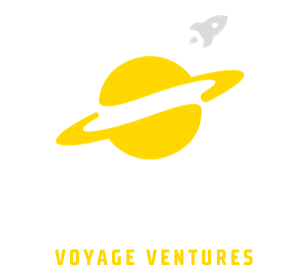
Interstellar Insights: Relativity Theory Through a Physicist’s Lens
- February 29th, 2024
- No Comments
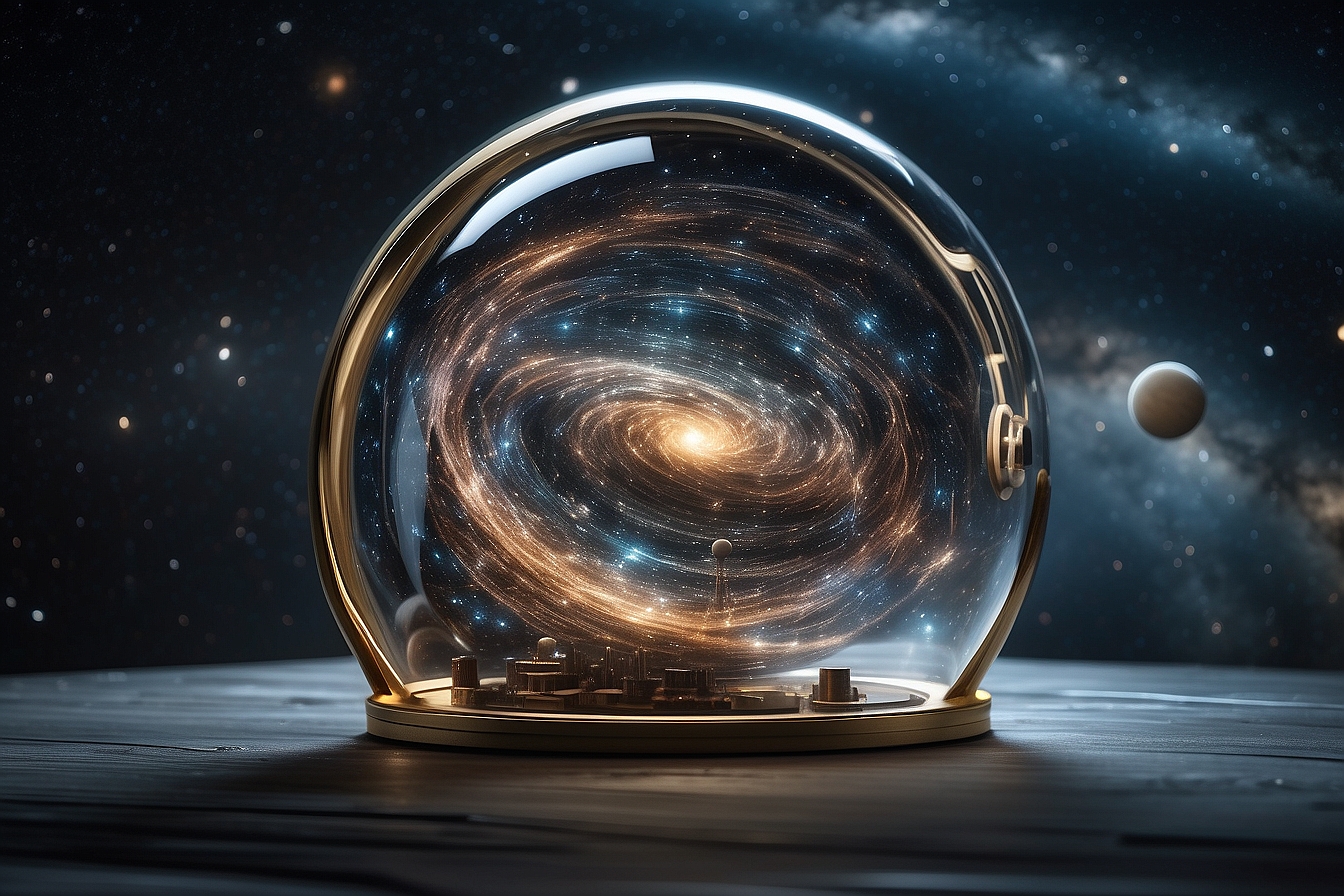
Table Of Contents
Interstellar Insights – The film “Interstellar” not only captivated audiences with its compelling narrative and stunning visuals but also served as a striking exploration of the theoretical underpinnings of the universe as depicted by Albert Einstein’s Theory of Relativity. Focusing on the challenges of interstellar travel, the film thoughtfully intertwines science fiction with sophisticated physics, presenting a story that pushes the boundaries of human understanding and cinematic storytelling. Renowned physicist Kip Thorne’s involvement in the film ensured that its portrayal of complex scientific concepts, such as time dilation and gravitational anomalies, adhered as closely as possible to current scientific theories.

While “Interstellar” journeys through the realms of speculative fiction, it does ground its narrative in the real science of space, time, and gravity. An important aspect of the film’s scientific backbone is the Theory of Relativity, which revolutionized how humanity perceives the cosmos. Einstein’s legacy looms large as the characters navigate through wormholes, experience time differently near massive bodies like black holes , and wrestle with the laws of physics that govern their reality. This tale pushes the viewer to consider the true nature of our universe and the current limits of human knowledge and capability in space exploration.
Key Takeaways
- “Interstellar” merges cinematic fiction with real-world physics, particularly Einstein’s Theory of Relativity.
- The science behind the film, rooted in actual theoretical physics, offers a depiction of space-time, black holes, and relativity.
- Portraying the concept of interstellar travel challenges and inspires viewers to think about humanity’s place in the universe.
The Legacy of Albert Einstein

Albert Einstein’s revolutionary discoveries fundamentally reshaped our understanding of the universe . His work on the general theory of relativity provides not just a framework for modern physics but also a lens through which we view space and time.
Foundational Principles
Albert Einstein forever altered the course of physics with his formulation of general relativity in 1915. This theory unveiled gravity as a consequence of the warping of space-time, caused by mass and energy. General relativity has stood the test of time, consistently confirmed by astronomical observations and experiments. Its implications reach far beyond the academic realm, affecting everything from GPS satellite navigation to our understanding of black holes and the expansion of the universe.
Einstein-Rosen Bridge
Among the many intriguing solutions to Einstein’s field equations in general relativity is the concept of the Einstein-Rosen Bridge , often referred to as a ‘wormhole’. Initially postulated in a paper by Einstein and physicist Nathan Rosen, this theoretical tunnel connects disparate points in space-time, positing a shortcut through the universe. While wormholes have captured the public’s imagination and are a staple of science fiction , they remain a speculative yet fascinating consequence of Einstein’s groundbreaking work in the fabric of space-time.
Interstellar Travel in Theory and Fiction
Interstellar travel captivates the imagination, merging the rigor of theoretical physics with the creative liberty of science fiction stories. It stands at the convergence of humanity’s quest for new horizons and the scientific community’s understanding of the universe.
Concepts from Science Fiction
The concept of interstellar travel in science fiction is rooted in the idea of surpassing the vast distances between stars within a human’s lifetime. Sci-Fi often employs advanced technologies and theoretical constructs to make this possible. One prominent example is seen in the movie Interstellar , where characters traverse these immense distances through a wormhole, a theoretical passage through spacetime that can create shortcuts for long journeys.
Examining the Alcubierre Drive
In the realm of theoretical physics, the Alcubierre Drive stands out as a concept that could, theoretically, permit faster-than-light travel, echoing science fiction narratives. Proposed by physicist Miguel Alcubierre in 1994, this speculative technology would involve warping spacetime around a spacecraft. However, the energy requirements and exotic matter needed for an Alcubierre Drive are beyond our current capabilities, reaffirming that interstellar travel remains a vision for the future rather than a current reality.
Exploring the Cosmos

In the vast expanse of the universe, the theoretical possibilities of space travel through wormholes and around black holes captivate physicists and laypersons alike, presenting complex challenges rooted in Einstein’s Theory of Relativity.
Wormholes and Black Holes
Wormholes—hypothetical passages through spacetime—offer a tantalizing means of instantaneously traversing vast distances in the universe. The movie “Interstellar” portrays these phenomena as cosmic shortcuts, which, if traversable, could revolutionize our understanding of travel among the stars. Research into wormholes and their potential for real-world space exploration remains an area of intense scientific interest.
Black holes , on the other hand, are regions of spacetime exhibiting gravitational forces so strong that nothing—not even particles and electromagnetic radiation such as light—can escape from inside it. They play a central role in the film, demonstrating their powerful influence on time dilation, a major prediction of the Theory of Relativity. The depiction of a black hole in “Interstellar” was based on theoretical equations , contributing to a visually accurate portrayal that educated audiences about their appearance and properties.
The Role of Exotic Matter
Exotic matter refers to hypothetical substances that possess unusual properties, such as negative mass or energy density. It’s theorized to be a critical component for creating and maintaining wormholes, as it could theoretically counteract the gravitational pull that would naturally close these spacetime bridges. Interstellar” draws on this concept through its narrative, using exotic matter as a plot device that allows characters to navigate the cosmos . This concept pushes the boundaries of our current understanding and prompts ongoing research within the field of astrophysics.
Each topic discussed here, from the exotic matter required to stabilize wormholes to the extreme gravitational effects of black holes, exists at the edge of our scientific knowledge and the forefront of space exploration discussions. As humanity looks to the stars, these theories lay the groundwork for our cosmic aspirations and the potential for unprecedented exploration of the universe.
The Dynamics of Space and Time
Exploring the intricate ballet of the cosmos necessitates an understanding of the fabric that constitutes the universe: space-time. This fabric bends and stretches, illustrating the profound relationship between space, time, and gravity.
Understanding Space-Time
Space and time are interwoven into a single continuum known as space-time . This four-dimensional fabric serves as the canvas upon which the universe paints its phenomena. One cannot alter one aspect, such as time , without affecting the other, like distance . The Theory of Relativity put forth by Albert Einstein revolutionized the way physicists perceive these entities, proposing that the laws of physics are consistent throughout this continuum.
- Space : Often visualized as a three-dimensional grid extending in all directions.
- Time : Acts as the fourth dimension, a temporal component vital for determining sequences of events.
This framework allows physicists to understand how the universe operates as a cohesive whole, rather than as isolated elements.
Gravity’s Influence on Time
Gravity, a curving of space-time by mass, influences both the passage of time and the trajectory of objects in space. The more massive an object, the deeper the curve and the slower time flows in its vicinity. This is not just conjecture but has been measured—clocks closer to Earth’s surface, where gravity is stronger, literally tick slower than those at higher altitudes.
- Near massive objects : Time dilation occurs due to the stronger gravitational pull.
- Higher altitudes : Weaker gravitational influence results in faster passage of time.
This relationship between gravity and time is not merely abstract but has practical implications for technologies like GPS satellites, which must account for these differences to maintain accuracy. The movie “Interstellar” showcases these concepts, with scenarios where characters experience time at different rates due to the varying forces of gravity they encounter.
The Physics of Mass and Movement

In the realm of physics, mass and movement are fundamental concepts, each governed by their own set of rules. Understanding how mass interacts with forces and the role of speed and light is crucial for grasping the mechanics of the universe.
Matter and Its Properties
Matter is composed of particles with mass and volume. From a physicist’s perspective, any object with mass possesses gravitational pull; the more mass an object has, the stronger its gravitational field. Newton’s Second Law of Motion states that force is equal to mass times acceleration ((F = m \cdot a)), underscoring mass as a pivotal factor in the calculation of movement. In the context of space exploration , the concept of mass becomes even more significant when considering the propulsion of spacecraft and the effects of gravity on interstellar travel.
Speed and Light
Understanding the relationship between speed and light is central to the theory of relativity, which asserts that the laws of physics are the same for all non-accelerating observers. Light, which is comprised of photons, travels at a speed of approximately (3 \times 10^8) meters per second in a vacuum. This universal constant, denoted (c), is a cornerstone in the equations of relativity and has profound implications for space travel . For example, as objects move closer to the speed of light, relativistic effects like time dilation become more pronounced, which has to be considered when planning long-duration space missions .
Observational Astrophysics
In the realm of astrophysics, observational techniques stand as the bedrock for exploring the universe, allowing scientists to gather empirical evidence and test the boundaries of theoretical models like the Theory of Relativity.
Detecting Signals across Space
To grasp the vastness of space, astronomers rely on advanced detection methods. These include radio telescopes and space-based observatories that collect electromagnetic signals. Such tools have been pivotal in confirming the existence of gravitational waves , a prediction of Einstein’s general theory of relativity. NASA’s continued efforts in this field are vital for enhancing our understanding of the cosmos, contributing to discoveries of phenomena such as black holes and neutron stars which emit these ripples in spacetime.
One of the most significant advances in recent years has been the development of techniques to isolate and identify these signals amidst the cosmic noise. By capturing this data, scientists can create detailed maps of stellar objects and gain insights into the life cycle of stars and the fabric of spacetime itself.
Planetary Discoveries
The search for planets outside our solar system has been revolutionized by both ground and space-based telescopes. Discoveries of exoplanets sit at the heart of this pursuit, with missions like NASA’s Kepler telescope having identified thousands of these distant worlds. Using methods like transit photometry, where astronomers observe the dimming of a star as a planet passes in front of it, the specific characteristics of these planets, including their composition and potential habitability, are being unveiled.
Observational astrophysics not only furthers our knowledge about the existence of planets and the potential for life beyond Earth, but it also tests our understanding of planetary formation and evolution. Each new discovery made by scientists works to piece together the complex puzzle of our universe’s story.
The Nature of Scientific Inquiry

In exploring the depths of space through science fiction, both authors and physicists contribute to the scientific inquiry. They expand our understanding of complex theories like relativity and its practical implications.
Methodologies in Modern Physics
In modern physics , methodologies are structured around empirical evidence and mathematical rigor. Experiments in physics, much like those that validate aspects of the Theory of Relativity, require meticulous setup, observations, and validations. This process often involves the following steps:
- Observation : Noting a phenomenon that requires explanation.
- Hypothesis : Proposing a tentative explanation based on prior knowledge.
- Experimentation : Testing the hypothesis through controlled experiments.
- Analysis : Interpreting the data gathered from the experiments.
- Conclusion : Drawing a conclusion that either supports or refutes the hypothesis.
For instance, physicists studying the time dilation effect as depicted in science fiction movies like Interstellar may conduct experiments involving high-speed particles to observe the effect directly. They employ complex mathematical models, often using Einstein’s field equations, to predict outcomes that can be tested.
The Human Element
The human element in scientific inquiry is multifaceted. Physicists are not only driven by curiosity but also by the desire to solve real-world problems, like finding habitable planets as portrayed in Interstellar . The nature of their work demands creativity, a trait often associated with authors , to imagine solutions and new experiments. This element is especially critical when traditional methods fail to provide answers.
Physicists also grapple with philosophical questions about our place in the universe and the ethical implications of their work. Such introspections reflect in science fiction narratives as well, where authors mirror these concerns through compelling stories. Human emotions, ambitions, and fears inform both the creation of speculative worlds and the pursuit of knowledge about our own.
In sum, scientific inquiry is a dynamic interplay of rigorous methodology and human curiosity, both of which are stimulated and reflected in the realms of science fiction and physics.
Interstellar Insights: Frequently Asked Questions

This section addresses some common inquiries about “Interstellar” and its scientific underpinnings, particularly the theory of relativity, providing insight into the movie’s alignment with actual physics.
How accurately does ‘Interstellar’ portray the theory of relativity?
“Interstellar” takes considerable care in its depiction of the theory of relativity, especially in the portrayal of time dilation near massive celestial objects. Caltech physicist Kip Thorne played a significant role in ensuring the film’s scientific veracity, though some dramatization for narrative purposes is present.
Can the representation of black holes in ‘Interstellar’ be reconciled with current physical theories?
The black holes in “Interstellar,” including Gargantua, are visualized with inputs from theoretical physics and are some of the most accurate representations in cinema to date. Their depiction aligns closely with what current physical theories predict about these massive phenomena.
In what ways did physicists contribute to the scientific aspects of ‘Interstellar’?
Physicists, notably Kip Thorne, were integral to “Interstellar,” providing expertise on the scientific aspects of the film. Their contributions range from the depiction of black holes and wormholes to incorporating the effects of relativity throughout the movie.
What are the theoretical implications of wormholes as depicted in ‘Interstellar’?
While wormholes like the one in “Interstellar” are speculative, they are grounded in theoretical physics, based on solutions to Einstein’s field equations. Their cinematic portrayal brings attention to the concept of shortcuts through spacetime, which remains a topic of scientific debate and exploration.
How does ‘Interstellar’ handle the concept of time dilation, and is it consistent with relativity?
The movie presents time dilation in a manner that is broadly consistent with Einstein’s theory of relativity. Characters experience time differently depending on gravitational forces, particularly near the black hole, aligning with the theoretical predictions connected to strong gravity.
What aspects of ‘Interstellar’ have sparked the most discussion within the scientific community?
The film’s use of black holes, wormholes, and time dilation as plot devices has sparked discussions and interest in the scientific community. These conversations revolve around the feasibility of interstellar travel , the nature of time and space, and the visualization of abstract scientific concepts.
Leave a Reply Cancel reply
Your email address will not be published. Required fields are marked *
The Legacy of 2001: A Space Odyssey – Insights into Predictions Realized
The real science behind “the martian”: assessing our progress in martian agriculture, the psychological effects of space travel on tourists: insights into the astronaut experience, the evolution of space tourism: how cosmic travel became attainable, the role of private companies in advancing space exploration initiatives, spaceports around the world: unveiling global launch sites.
The Ending Of Interstellar Explained
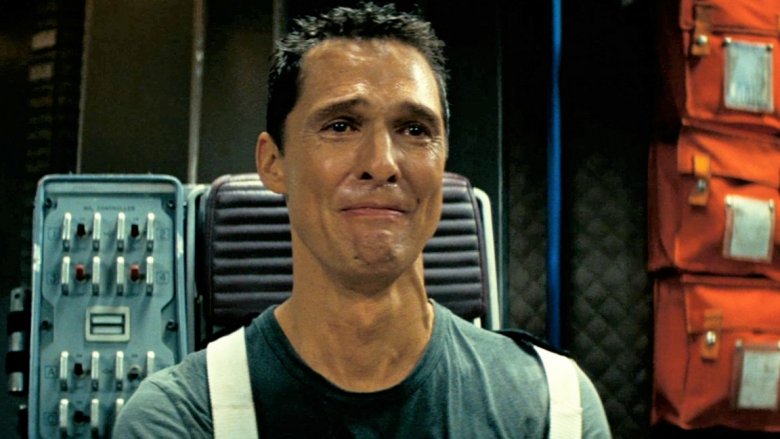
Christopher Nolan has never been one to shy away from unconventional narratives and complex story structures , whether that means telling a story backwards in Memento, questioning our perceptions of reality and time in Inception , or poking at the nature of identity and individualism in The Prestige. So when he released his time-slipping space epic, Interstellar — a tale about humanity's efforts to escape a dying Earth for a new home in the stars — it shouldn't have come as a surprise when it was anything but straightforward.
Even if you're mostly able to follow the movie through its first two hours of wormholes, gravitational propulsion theory, and the relativistic passage of time, we wouldn't blame anybody if they got lost in the film's final hour. Not only does every major theme and theory of the film come to a head as the story builds towards its climax, but it also throws a major curveball at the audience in the form of an infinite, interdimensional library that literally comes out of nowhere.
Fortunately, if you've been having trouble making sense of what happens at the conclusion of the film, we've got answers. Below, we do our best to walk through the bizarre, mind-bending ending of Interstellar .
What was Dr. Mann trying to do in Interstellar?
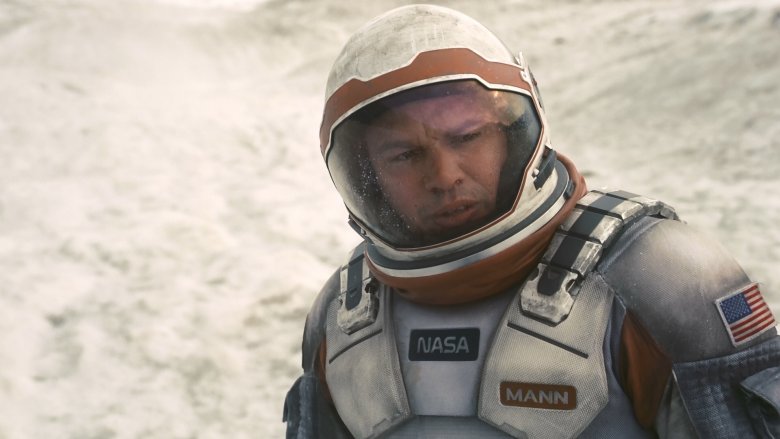
Life on Earth isn't great in Interstellar . Massive dust storms are tearing up the planet , crops are failing, and soon, humanity will cease to exist. Looking for answers, NASA turns to the skies, hoping for an answer.
As we learn at the beginning of the film, a group of 12 scientists traveled through a mysterious wormhole that appeared near Saturn, to see if the 12 planets on the other side could sustain human life. A few years later, the Endurance and its crew — including Cooper (Matthew McConaughey) and Brand (Anne Hathaway) — are going to visit the three most promising planets in the hopes of colonizing one. When they arrive on Dr. Mann's (Matt Damon) planet, the heroic scientist assures them his icy cold spot is the perfect place for humans to live.
Unfortunately, it's soon all revealed to be a ruse. Although each of the original 12 scientists knew their trip was one-way, Mann admits he never fully considered the possibility that his planet would be uninhabitable, and that he might die alone. Although he resisted the urge for years, he eventually falsified his survey data in order to coax another team to travel to his planet, intending to use the Endurance to escape. At this point, Mann is so desperate to leave that he'll do anything, even commit murder. Paranoid that the Endurance crew won't go along with his plan once they learn what he's done, Mann attempts to kill Cooper so he can make his getaway. Yeah, it's a murderous Matt Damon , which we don't often get to see on-screen.
Why does Murph burn Tom's fields?
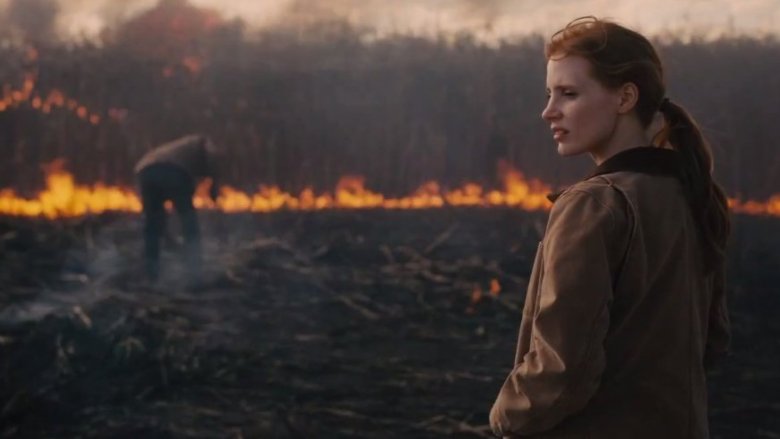
Back on Earth, Cooper's now-grown children find themselves at odds. His daughter, Murph (Jessica Chastain), has realized the surface of our planet has become uninhabitable. So naturally, she's trying to persuade her brother, Tom (Casey Affleck), to bring his family to the secret NASA facility where she's been working on the gravitational equation that would allow humanity to escape into space en masse. But despite Murph's warnings (and the fact that his son is really sick), Tom refuses to abandon the farmhouse where he and Murph grew up. After Cooper left them in their grandfather's care when they were children, never to be heard from again, Tom lost all faith in NASA's ability to help them.
Convinced her brother is making a terrible mistake, Murph sets fire to Tom's corn fields, knowing that since Tom relies on his crops for survival, he'll be forced to drive out to try to extinguish the blaze. That buys Murph enough time to return to the house and evacuate Tom's wife and son, likely in the hopes that once Tom realizes his family has gone to the NASA facility, he'll have no choice but to join them. Hey, desperate times call for desperate measures. But Murph's involvement in the story is far from being over.
How does Mann's plan go wrong?
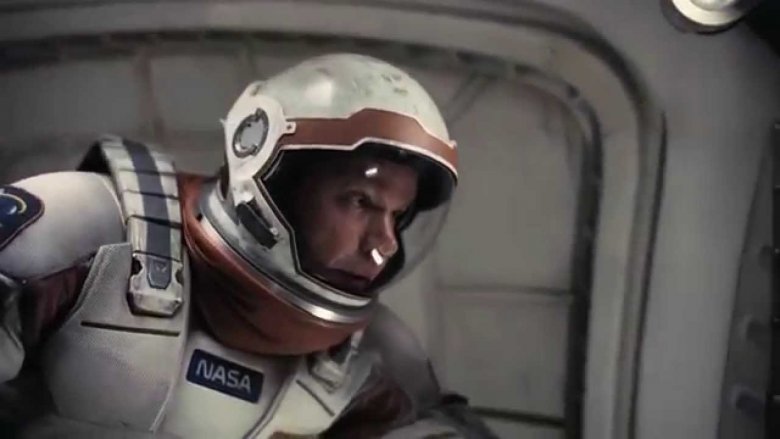
In order to keep anyone from discovering that he'd falsified his survey data until after his escape, Mann sabotaged and booby-trapped his robot that had been storing the fake data. Mann's tampering leads to a massive explosion, but Endurance robot TARS is able to escape. Better still, TARS reveals that he's disabled the automatic docking procedure for the shuttles, which means that even though Mann has stolen Cooper's shuttle, he's unable to dock with the Endurance .
Meanwhile, Cooper survived Mann's attempt to kill him long enough to call for help, and Brand picks him up in the second Endurance shuttle. Although Brand and Cooper caution Mann that attempting to manually dock with the Endurance won't work, the scientist tries anyway, determined to escape his planet by any means necessary. But as soon as he attempts to depressurize the shuttle's airlock so he can enter the Endurance , the airlock explodes, killing Mann and sending the Endurance into a rapid spin.
With the help of TARS and the other Endurance robot, CASE, Cooper is eventually able to successfully dock with Endurance and stabilize the spin. But by that point, the ship is severely damaged and lacks enough fuel to travel anywhere safe, leaving Cooper and Brand effectively stranded in space. Talk about a rough day on the job.
What is Cooper's plan to get to Edmunds' planet?
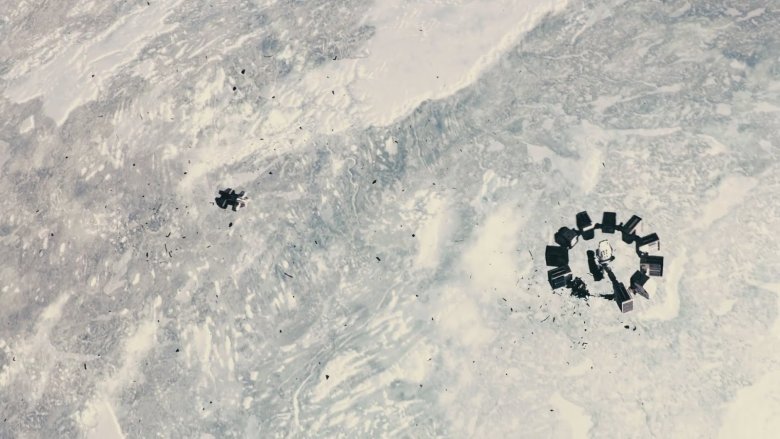
Without enough fuel to either return to Earth or travel to the third potentially habitable planet (colonized by a scientist named Edmunds), Cooper proposes to use the gravity of the black hole Gargantua to execute a slingshot maneuver, which would send the Endurance off with enough inertia to reach Edmunds' planet. However, as was established earlier in the film, every time the Endurance crew approaches the black hole , its gravitational field distorts their perception of time due to relativity, meaning what they experience as only minutes passes as years for anyone outside Gargantua 's gravity.
By executing Cooper's slingshot maneuver, he and Brand will experience "time slippage" of 51 years. They both realize this means Cooper will have to give up hope of ever seeing his children back on Earth, as they will likely have died of old age by the time the Endurance exits Gargantua 's gravity. Still, Cooper knows that his plan is humanity's last chance for survival.
Adding even more drama to Cooper's decision is Mann's earlier speech about the moment humans experience before death. According to Mann, as our brains grasp at survival, we'll experience a vision of the thing we most desire to see again. Mann speculates that Cooper's final image will be of his children, since they're his reason for living. By giving up hope of seeing his children again, Cooper is prioritizing the future of humanity over his own motivations for survival.
Why do TARS and Cooper get pulled into Gargantua?
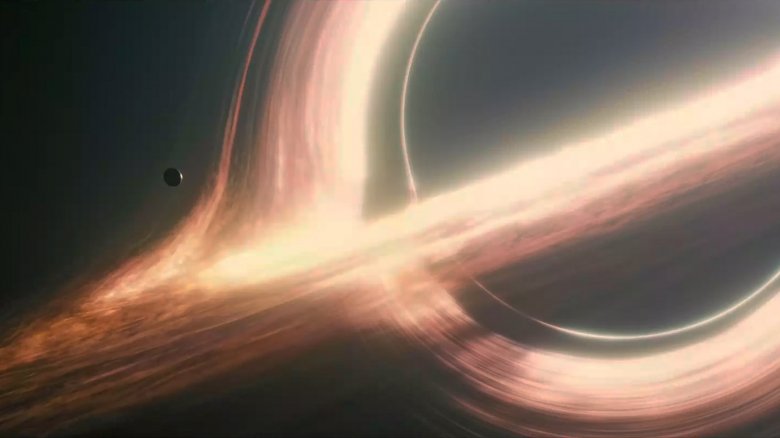
With its depleted fuel supplies, in order for the Endurance to pull free of Gargantua' s gravity after completing Cooper's slingshot maneuver, the ship has to decrease its weight. Before beginning the maneuver, Cooper decides the shuttle holding TARS will detach and drop into the black hole. In addition to relieving the Endurance of the shuttle's weight, Cooper hopes that TARS can collect the quantum data from inside the singularity that NASA scientists on Earth need to complete the gravitational equation that will allow humanity to leave. While odds are slim that TARS will be able to transmit this data back to Earth, Cooper is determined to at least try, since it's his children's last hope of survival.
However, Cooper doesn't tell Brand that losing TARS' shuttle won't account for a big enough drop in weight. In fact, an additional shuttle has to detach in order for the Endurance to escape. Cooper decides that he should bite the proverbial bullet, leaving Brand to continue on to Edmunds' planet and restart the human race with a whole bunch of embryos on board the Endurance . He doesn't tell Brand until the last moment because he knows she would argue with his decision, but even without the possibility of seeing his children again, Cooper is at peace with his probable death.
How does Cooper survive the black hole, and where does he go?
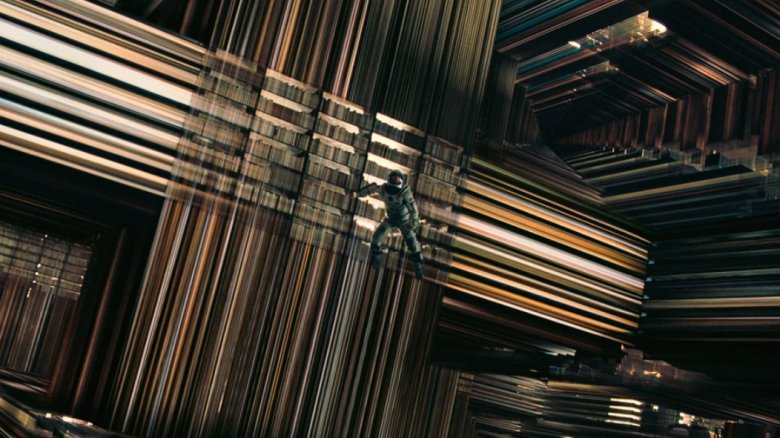
After falling into the black hole, Cooper continues to record what he's seeing and transmits it back to TARS, hoping the additional data might help the scientists back on Earth. Although he expects to eventually get crushed by Gargantua 's gravity, Cooper is miraculously spared once his shuttle is ripped apart. And that's when things get crazy. After surviving the wild ride, Cooper gets transported to an infinite, interdimensional library that allows him to look back into different moments in his daughter's childhood bedroom, including the day he left for his mission on the Endurance .
TARS determines that they made it through Gargantua alive because they were protected by "them," the mysterious beings who constructed the wormhole that allowed the Endurance to travel to this new galaxy in the first place. Since the beginning of the film, who "they" are has been a mystery. While NASA realized the wormhole (the one that shows up by Saturn, earlier in the movie) was artificially constructed by some sort of advanced intelligent beings, they didn't have any information about "them" beyond the assumption that they must be benevolent, since humanity's only chance at survival is due to the wormhole. TARS deduces "they" also must have built this library in order to help Cooper understand their five-dimensional reality. And sure, it's confusing, but it's also nice to have otherworldly beings on your side.
Why does Cooper see Murph in the black hole?

Although the library where "they" bring Cooper seems to go on forever, every part of this room serves as a window into the exact same place: his daughter Murph's childhood bedroom. At first, Cooper seems to think he's been brought to her because of his own desire to see her again, but TARS helps him understand "they" have constructed this three-dimensional reality for Cooper, allowing him to access all five dimensions in a way he can understand.
Together, TARS and Cooper figure out that through the library, Cooper is able to physically influence different points in space-time by using gravity to move things (time and gravity being the fourth and fifth dimensions that exist in "their" reality). But what's the point of all this? Well, Cooper deduces that he's been brought here to send a message back through time, using gravity, and that Murph has to be the one to receive it. Cooper realizes that while he thought "they" were fixated on him, he's not actually the one who's most important to saving humanity — Murph is. The library exists to ensure that Cooper will be able to deliver his daughter the information she needs, right when she needs it.

What is Cooper trying to do in Murph's room?
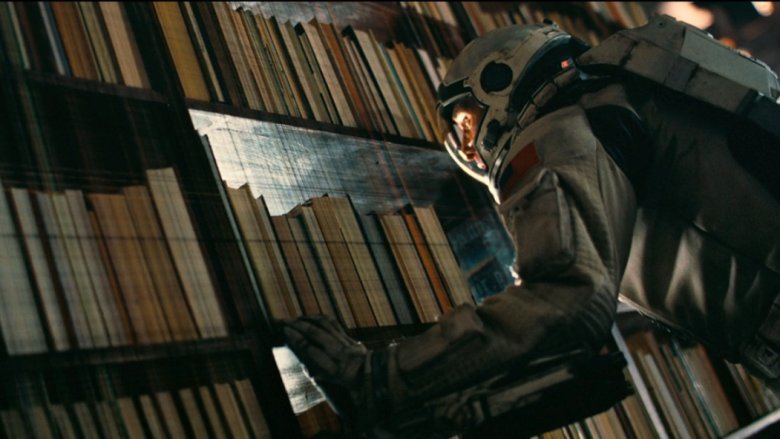
At first, when Cooper sees the young Murph, he tries sending her a message that he shouldn't leave on the Endurance , using the books on her shelf to spell out "S-T-A-Y" with Morse code. Cooper seems to think that if he can prevent himself from leaving Earth, he can somehow be reunited with his family, erasing all the years he missed with his children after departing on his journey. But as we saw at the beginning of the film, while young Murph (Mackenzie Foy) gets his message, she's unable to convince her father to stay. The library allows Cooper to perceive all five dimensions, but it doesn't allow him to change any of them. He can't rewrite time any more than he can stop being three-dimensional.
TARS realizes this, telling Cooper "they" didn't bring him to the library in order to change the past. Only then does Cooper accept the reality of his situation, and understand that he's not there to change things that have already happened. Instead, he's here to shape and influence the future. With TARS' help, he gives young Murph the coordinates to the NASA facility that led to his mission on the Endurance in the first place. Plus, he shares some info that might just save humanity.
So who are 'they' in Interstellar?
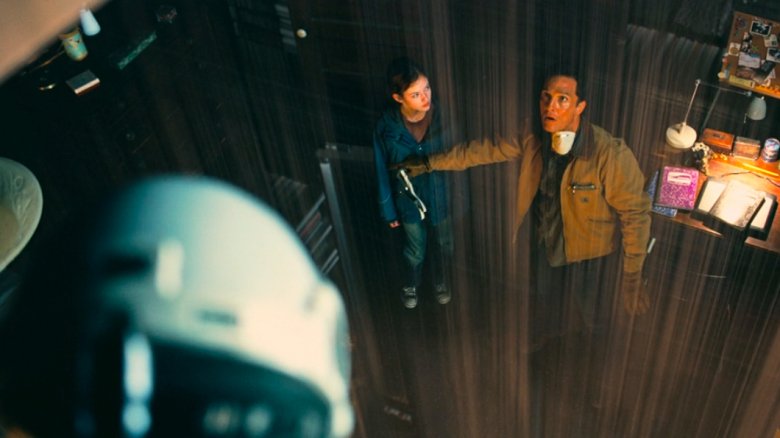
After Cooper finds himself stuck in the library, he realizes he's supposed to pass along the quantum data that TARS collected from inside Gargantua . The information the robot gathered from inside the black hole will help Murph save mankind, and Cooper is the interdimensional messenger, selected by the same mysterious forces that constructed this library and created the wormhole near Saturn. And once Cooper understands his new purpose, he realizes the creatures who've been assisting humanity aren't extraterrestrial at all. "They're not beings," he says. "They're us."
As it turns out, at some point in the future, humanity will advance to a point where we can navigate through all five dimensions. It's these future humans who used gravity to create the wormhole that allowed NASA to send scientists to explore the 12 planets in the first place. These future humans are also the ones who protected Cooper from the effects of Gargantua . Just as Cooper is able to use the library to influence events that, for him, already happened, the humans of the future have been using their understanding of time and gravity to ensure their own survival by assisting Cooper, Murph, NASA, and the other humans of their past.
What's love got to do with it?
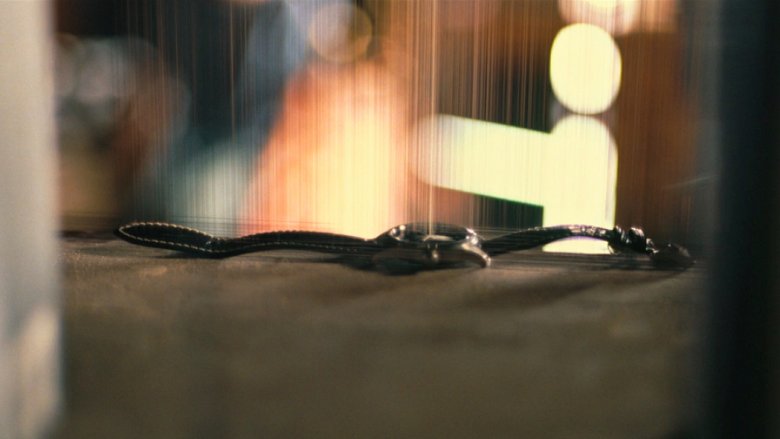
After realizing why the library exists and that "they" want Cooper to give Murph the quantum data she needs to save the world, TARS asks how Cooper plans to communicate such complex information from another dimension. After considering it for a moment, Cooper tells TARS that love is the key. The robot doesn't understand, but Cooper explains that he can trust his love for his daughter to guide him to exactly where he needs to be. As Brand explained earlier in the film, love is the only thing that transcends all dimensions , including time and space.
Cooper decides to code the quantum data into the second hand of the watch he gave Murph before he left, assuring TARS that she will one day return for it. When TARS asks how Cooper can be sure, he responds, "Because I gave it to her," confident that her love for him will lead her where she needs to go, just as his love led him back to her.
Sure enough, as all this is happening, the adult Murph has indeed returned to her childhood bedroom, drawn by an unseen force. She suddenly understands the "ghost" from earlier in the film, the entity trying to contact her with dust patterns on her bedroom floor, was actually her father. Reminded of her love for him, she finds the watch, and voila, things are suddenly starting to look up for humanity.
What happens in Interstellar after Cooper delivers his message?
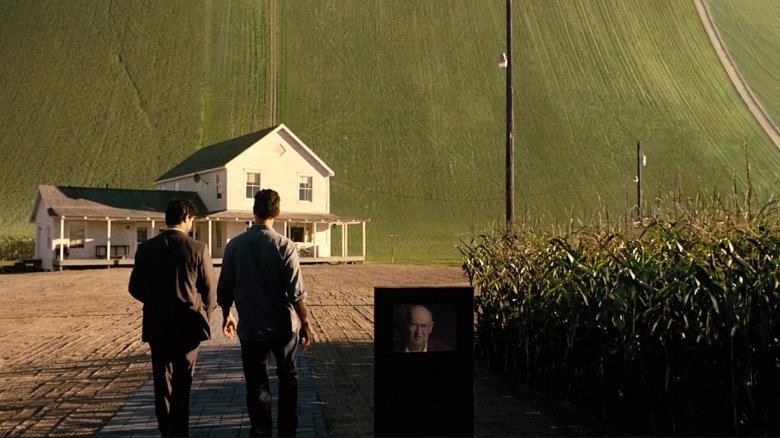
With the planet dying, humans need to evacuate the place fast. But to solve the gravitational equation that allows humanity to escape from the tethers of Earth, you need quantum data gathered from inside a black hole. Thinking that collecting such data is impossible, Murph believes the people of Earth are doomed, and that her father has abandoned her. However, once she realizes that Cooper was her childhood "ghost" and that he's given her the data she needs through the watch, she's able to solve the equation, ensuring humanity's survival.
Once Cooper passes along the quantum data, the tesseract (aka the library) begins to collapse, having served its purpose. Cooper loses consciousness, and he later wakes up on a space habitat orbiting Saturn. Just as "they" brought Cooper to a library and allowed him to communicate with his daughter and save humanity, "they" also brought him back back to safety once he was finished with his mission. Only instead of Earth, he's now on a gigantic colony floating through space . Thanks to Murph's calculations and the data acquired from the black hole, humans were finally able to leave Earth en masse, and now they're spread out over several different space habitats. And it's all thanks to those mysterious forces, who helped Cooper in the library and made sure people would find him once it was time for the library to close.
Where does Cooper go at the end of Interstellar?
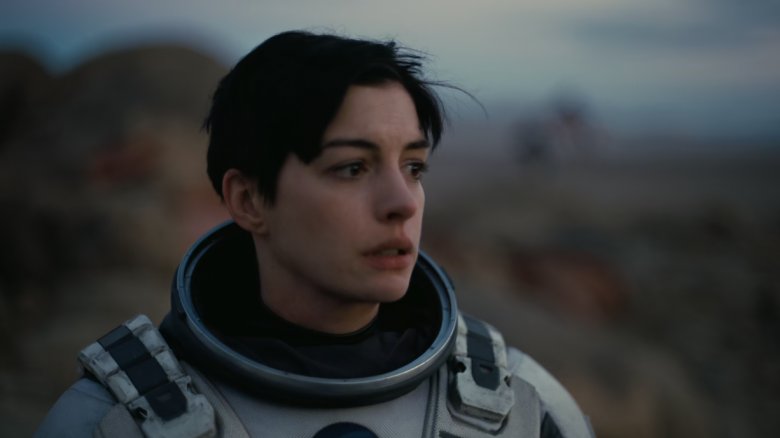
Due to the "time slippage" that Brand warned about before executing the slingshot maneuver around Gargantua, at least 51 years have passed for the people of Earth (and possibly even more, since Cooper spent more time in the black hole than he factored into the slingshot calculation). However, it's only been hours for Cooper. By the time he makes it to the space habitat known as Cooper Station, his daughter Murph, whom he last saw as a little girl, is an old woman on the verge of death. On the flip side, Cooper appears to be about the same age as he was when he left.
While Cooper is overjoyed to finally be reunited with his daughter, Murph knows that she won't live much longer, and tells Cooper that he should go so that he doesn't have to watch her die. Cooper takes his daughter's advice and steals a ship, intending to head back through the wormhole and join Brand on Edmunds' planet. Like Cooper, she would've only recently arrived, and she'll soon be entering hyper-sleep, keeping her the same age until he reaches her.
Sadly, Edmunds himself has died at some point during the decades he spent waiting for NASA to send a team to his planet. But as Brand takes off her helmet and breathes in the air of her new home at his grave site, it's evident this is the planet the astronauts have been searching for, where humanity can rebuild and, eventually, thrive again.
How much time has passed for each character by the end of Interstellar?

Although we never learn exactly what year it is at the beginning of Interstellar , for the first half of the film, the timeline seems pretty straightforward. Even when the narrative begins easing into the concept of relativity — that gravity will cause some characters to experience time differently than others — it does so in baby steps. It's easy enough to understand how two years pass on Earth while only a few months go by for the hibernating crew of the Endurance, suspended in their cryosleep pods.
But once the Endurance hits the water planet, keeping track of time becomes much trickier. While Cooper and Brand only experience a few hours, the people of Earth, including Murph, live another 23 years. However, while Romilly is also in Earth-time, he goes into hibernation for a few long stretches, so he may have only aged a decade or so during those 23 years. By the time they leave the water planet, it's been a few months since departing Earth for Cooper and Brand, 25 years for Murph and NASA, and somewhere in between for Romilly.
The next big jump happens during the slingshot around Gargantua, after Romilly dies. While we never learn precisely how many years Cooper and Brand lose during their Hail Mary maneuver, it's probably somewhere around 60 years, since by the end of the film, we're told that Cooper is technically 124 years old, and he was likely in his late 30s or early 40s at the start of the film. However, even though around 85 years have passed for Murph and the people of Earth since Cooper left on the Endurance , it's only seemed like a few months for him. The same is true for Brand, who experienced the same time slippage as Cooper, which is why she and Cooper are the only ones to end the film around the same age they were when it began.
What was the equation Murph was trying to solve in Interstellar?
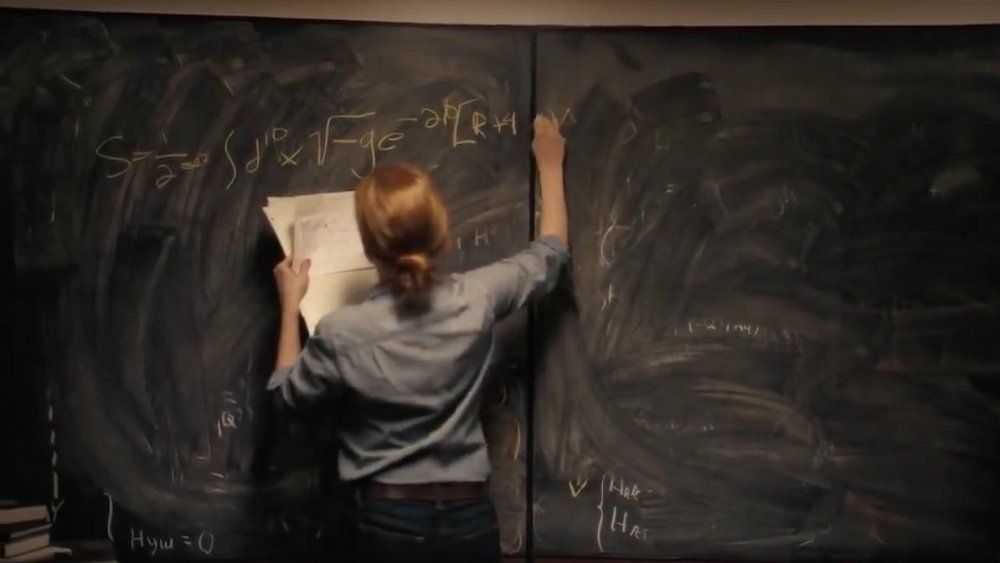
There's a lot of talk throughout Interstellar about the gravitational equation that Professor Brand, and later Murph, spend decades trying to solve. Brand tells Cooper early on that in order for "Plan A" to succeed — which involves humanity relocating to a new planet in another solar system — it's imperative that he solve the equation while the Endurance is out exploring potential new homeworlds. Later, Brand confesses to Murph while on his deathbed that he's always known the equation is unsolvable without the quantum data from inside the black hole, and that Plan A has been a sham from the beginning.
As for what the equation itself is supposed to accomplish, it all comes back to the film's recurring theme of gravity. In order for Plan A to work, Brand needs to figure out how to get the entire human race off of the planet aboard gigantic space stations. While humans have the technology to launch individual shuttles, the city-sized space stations are another story, and sending them into space requires humans to learn to manipulate gravity according to their will. Without solving the gravitational equation, humanity is simply too big to lift off Earth, and is doomed to a slow death on a dying planet.
However, Murph does wind up solving the equation after Brand's death, thanks to the data she receives from her father, her "ghost," through the tesseract. Interestingly enough, thanks to the way the tesseract allows Coop to communicate through time, Murph has actually had the data she needed to solve the equation for years, encoded in the watch her father left her; she just didn't realize it.
Where did Cooper Station come from at the end of Interstellar?
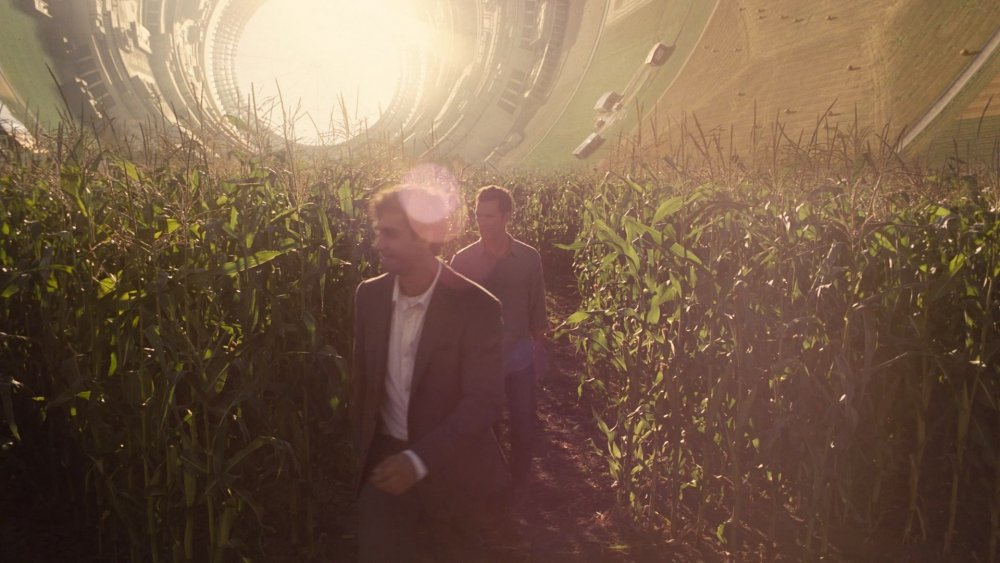
It may look almost unrecognizable, but the massive cylindrical space station where Cooper finds himself at the end of Interstellar is a setting we've seen many times. It is in fact the same subterranean NASA facility (or another one very much like it) that Cooper and Murph found at the beginning of the film, and in which Murph has been working ever since. Of course, when we've seen it before, its curved walls were sheer concrete, not cornfields and neighborhoods, so it's understandable if you thought Cooper Station was an entirely new location.
When Murph solved the gravitational equation, it enabled NASA to load up the remnants of humanity into their various stations (we don't know how many there are, but from the dialogue at the end of the film, we can gather that there are at least two) and launch them into space. Once they were free of Earth's gravity, they were able to repurpose the interior walls of the station to become the ground, freeing up much more living space for the station's inhabitants. So although Cooper Station looks very different by the end of the film, we actually see Cooper tour the same facility twice — once on Earth, and once in space.
How did Murph know where Brand was at the end of Interstellar?
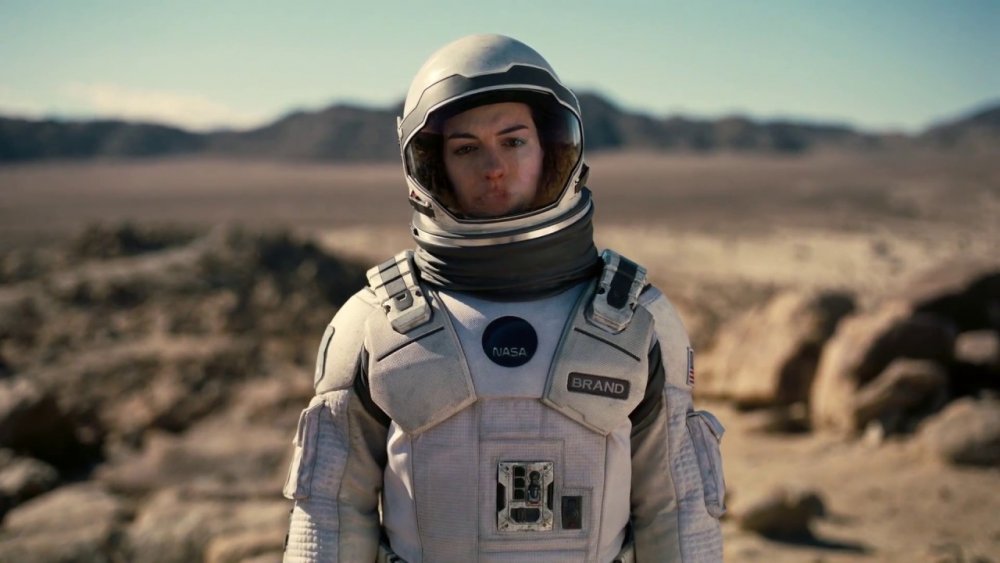
At first glance, it might seem strange that Cooper spends the whole film trying to get home to his kids, only to voluntarily take off again at the end of the film after only being reunited with Murph for about 30 seconds. However, even aside from the strangeness of Cooper immediately taking Murph's advice to fly back through the wormhole to find Brand, it's easy to wonder exactly how Murph even knew where Brand was, or that she was still alive.
Interstellar never gives us a definitive answer to this, but we can make a few educated guesses. When Cooper first wakes up on Cooper Station, he learns that Murph has been in cryosleep for the past two years, but that she was awakened once Cooper was found and immediately set out to come see him. While he waits for Murph to arrive, Cooper tours the station, moves into the replica of his old house on Earth, and repairs TARS. It's reasonable to assume that at some point during this stretch of time, he's also fully debriefed about what happened on the Endurance . After all, even if he was gone for decades, he's still a NASA pilot just returned from a government-sanctioned mission. Getting his official account of everything he went through would be a top priority.
Given Murph's importance to NASA and the human race as a whole by the end of Interstellar , it's not much of a stretch to assume that as soon as Cooper's report was complete, she got her hands on a copy. So even though the meeting between Murph and Coop at the end of the film is the first time they'd seen each other in decades, it would make sense that she'd already know about everything he experienced on his mission — including jettisoning himself into the black hole so Brand could make it to Edmunds' planet.
Isn't the ending of Interstellar a paradox?
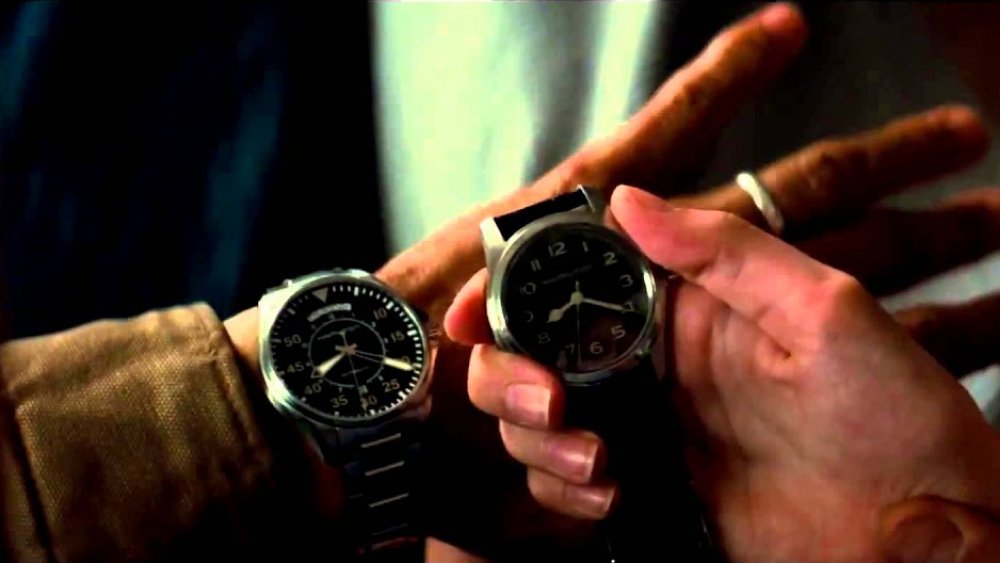
Once Cooper realizes toward the end of Interstellar that "They" are actually the humans of the future who created the tesseract and the wormhole in order to facilitate the survival of the humans of the past, it opens the door for some major questions. The most obvious one being, how can the humans of the future save the humans of the past, if the humans of the future can't even exist without the humans of the past surviving?
It's a theory known as a " bootstrap paradox ," in which the cause of an event turns out to be the result of that same event. It seems impossible, but there may be an explanation that works within the world of Interstellar . One possibility is that in the "original" timeline, humanity did in fact die out on Earth, but Brand's "Plan B" colony on Edmunds' planet survived, evolved, and eventually developed the ability to travel through time and change the past, creating a new timeline.
However, there may be an even simpler explanation that doesn't rely on multiple timelines to work: time in Interstellar simply isn't linear. Multiple characters take great pains to explain throughout the movie that the way we understand time may in fact be very limited, and that the humans of the future may experience time very differently than we do. This could mean that our very notions of cause and effect aren't even true, and that our belief that cause must predate effect is actually incorrect. Perhaps, in the world of Interstellar , time isn't a line at all, and our fervent belief that cause and effect can only move in one direction simply highlights how much we don't understand.
Christopher Nolan's Interstellar Explained

Your changes have been saved
Email is sent
Email has already been sent
Please verify your email address.
You’ve reached your account maximum for followed topics.
Quick Links
The ending of the human race starts the expedition of a lifetime in interstellar, betrayal and faith propel interstellar further into space, what's the deeper meaning behind interstellar, the significance of mann in interstellar, the importance of murphy's watch in interstellar, the meaning behind "do not go gentle" by dylan thomas in interstellar, who are "they" in interstellar, key takeaways.
- Interstellar is Christopher Nolan's most ambitious work that showcases scientific real-life theories.
- Interstellar explores the existential question of what humans are willing to do to preserve life.
- Love and taking a leap of faith are central themes in Interstellar.
2014's Interstellar is a sci-fi masterpiece by Christopher Nolan. Thus far, it's been his most ambitious work, as it displays heavily researched scientific theories for the intricacies of space, time, wormholes, black holes, and everything in between. With the help of Physicist Kip Thorne, the two were able to create a thought-provoking, evocative, realistic approach to what traveling through space could look like.
Of course, there is always a second layer to Nolan's work — a deeper meaning behind time and humankind as we know it. Interstellar dives into the hopelessness of what humans will do to preserve life. What's more important? Is it saving what humans have now or preserving the human species for future generations? These questions are consequently answered through the journey of ex-NASA pilot Joseph “Coop” Cooper (Matthew McConaughey) as he travels through space hoping to return to his family.
Oppenheimer Is More Similar to Nolan's Dark Knight Trilogy Than Anyone Realizes
Christopher Nolan's Oppenheimer examines its titular hero losing the respect society once afforded him, which is similar to the Dark Knight Trilogy.
Interstellar takes place in the not-so-distant future. The Earth has been polluted by blights worldwide, enacting dust bowls that destroy common crops to present livestock. At this point, the world's population has lost interest in finding a solution to surviving outside of space. It has solely depended on living off its primary food source, corn. The protagonist, Coop, holds down acres of cornfields and is known for his exceptional farming abilities. His two children view the world through two different lenses. Tom ( played by Dune's Timothée Chalamet , Casey Affleck), sees the world as black and white and values the lands of sustaining the cornfields.
Murphy (Mackenzie Foy, Jessica Chastain) is just her father in some respects: she's a critical thinker who enjoys adventures. When Murph's books start falling off the shelf, she informs her family that she may have encountered a ghost. Coop initially dismisses her, but he understands this is unusual over time. After Murph leaves her window open during a dust storm, they encounter an anomaly. The dust has drawn out Morse Code to disclose the coordinates of a secret NASA station. There, Coop meets scientists and NASA board members who reveal there is a possibility to leave the Earth indefinitely and find another place that's livable. 50 years ago, an unidentifiable helper placed a wormhole near Saturn.
After projecting probes and creating the Lazarus group to travel to other planets to see if any are habitable, they are creating a second spaceship called Endurance to travel through the wormhole and collect the data from three viable planets. Dr. Brand (Michael Caine), a past Professor of Coop, asks him to pilot this expedition. This would mean he would leave behind his family and miss many years as time works differently from the gravitational pulls from other planets. The only reason Coop accepts is that he believes that his family and future generations will be saved. Brand shares with him that there are two plans to preserve life. Plan A is figuring out the gravitational quantum equation that will allow humans on Earth to travel to other parts of space. Plan B allows Earth to die out and creates a colony from farmed sperm and eggs to continue the species. Brand tells Coop plan A is the priority.
Sorry, Dark Knight Fans - Interstellar Is Christopher Nolan's Best Movie
While many fans and critics will consider The Dark Knight Christopher Nolan's best film, Interstellar proves itself superior in a multitude of ways.
Murphy is distraught that her father is leaving, but before he leaves, the bookshelf gives her a message: S-T-A-Y. After leaving a watch for Murph, Coop is off to outer space with Amelia Brand (played by The Dark Knight Rises' Anne Hathaway ), Doyle (Wes Bently), Romilly (David Gyasi), and two military robots, TARS (Bill Irwin), and CASE (Josh Stewart). The first planet they reach is Miller, a shallow, endless ocean conditioned to large waves due to the nearby black hole's gravitational pull. The downside of this planet is that it is not only uninhabitable, but each second they are there, a day passes.
When they return to space in order to regroup, an exceptional amount of time has passed, creating a more impending depressive state on Coop. The only thing he can do is push forward. Dr. Mann (Matt Damon) or Dr. Edmunds is between the last two potentially habitable planets. Both are likely candidates, but Edmunds' planet is much farther. Brand wants to choose Edmunds due to her expert opinion and because she's in love with her. Edmunds also argues that love can transcend and live beyond space, time, and dimensions. It's the one thing that has survived thus far. Ultimately, Coop chooses Mann as going there would preserve more fuel to return to Earth.
Mann's planet, Brand gets a message from a much older Murph informing her that her father is dead. She then asks if Brand knew that Plan A was never a viable option because Dr. Brand knew all along that the equation was unsolvable unless they had more information on black holes to fill the missing pieces to the equation. Distraught, Coop wants to get back home immediately but is betrayed by Dr. Mann who then attempts to kill him. He also learns that Mann's planet is uninhabitable and lied about his data to be rescued. This leaves Edmunds as the only planet left to try out. Realizing they don't have enough energy to get to Edmunds or to get home, Coop utilizes the gravitational field from the black hole to propel the spaceship into space, conserving enough energy to get to Edmunds. Coop sacrifices TARS and himself to get sucked into a black hole, allowing Brand to arrive at Edmunds safely.
Inside the black hole, Coop is transported to a tesseract — a five-dimensional space that defies time — and finds it's an endless scope of his daughter Murph's room. The audience begins to piece together that he was the ghost sending messages. He eventually devises a plan to send the missing numbers for the equation. TARS was able to contrive the information since they are inside Tesseract, which could solve the impending solution, and relays this information through the watch he had given Murph as a child. Simultaneously, Murph realizes that Coop is her ghost. She picks up the watch and sees the Morse Code from the watch. Coop makes it out alive and wakes up at a space station near Saturn. Murph had done it. She, along with her father, saved the Earth. By the time he sees Murph again, she is well into her 80s.
Inception's Spinning Top Explains Christopher Nolan's Entire Career
Inception's final shot explains Christopher Nolan's most consistent themes from his early films while also predicting a turning point in his career.
As plainly evident, there are a lot of different elements that create the masterpiece of Interstellar . With the heavily convoluted scientific background, the intention of the film can be a bit confusing. The straight and easy answer to the film is astronauts are trying to save the human race by finding somewhere safe to live. But why is Nolan telling this story? Most, if not all, of his projects have an underlying philosophical purpose. The topic of love is the driving force of Coop's will to survive. It's also his guide in believing Murph will eventually pick up the watch and understand the codes. It's even explained by Brand's character earlier in the film: "Love is the one thing we're capable of perceiving that transcends time and space."
Some viewers found these lines of dialogue cheesy and not a resourceful method for making decisions in space. But love is an emotion people tend to shy away from or condemn because it evokes a vulnerable side. This can be said about all emotions, but for whatever reason, love can guide intentional decisions. But rather than just love being the solution, it's also the familiar phrase: "taking a leap of faith." All the characters in Interstellar achieve what they deem desirable. Coop conveys those codes through Murph's watch because he believes that the power of their love — whether through separation through time or distance — will not diminish her love for her father.
Oppenheimer Surpasses Inception as Christopher Nolan's Third Highest-Grossing Film
Christopher Nolan's Oppenheimer continues to defy expectations as its profits continue to grow.
Mann's character as a whole is the representation of human beings. At first, he's considered a scientific symbol, having collected great success. But being left in solitude on a hopeless planet causes him to resort to other methods. His discussion with Coop on the planet about why drones aren't used to carry out missions signifies that deep down, no matter the cause, humans will survive if need be. He's the embodiment of what Plan B is. Self-preservation masks his selfish choices, which, by and large, affect everyone else around him.
The relativity of time is stated throughout the film and is Coop's motivation to get home. When Coop comes back from Miller's planet and watches the tapes of his family aging, he breaks into tears of the times he's missed, such as his children graduating from high school, Tom's marriage and his first child, and everything else after that. As time passes, both his children begin to lose hope and resent him for leaving. What remains the same is Murph's watch. From the time she throws it out of anger to the day she dies, it's still in pristine condition, resembling her love for her father. No matter how much time had passed, Murph still loved her father.
Barbie Oppenheimer Is an Actual Person, and She's Having a Weird Time
The two pillars of Barbenheimer, Oppenheimer and Barbie, have finally found the one person who can connect the two beyond social media.
The famous poem "Do not go gentle into that good night" by Dylan Thomas is said more than a few times in the film, primarily by Dr. Brand. In itself, the poem describes the human condition in the face of death, and how regardless of the type of life one has led, the poem instructs the reader to not give up on their life easily. This is precisely what Coop does with the power of love. His motivation makes him persevere and take risks to return to his children. Although he could have died at any given point by falling into the black hole, it's the only other way to get back to his children. In doing so, he helps save humanity by dropping directly into the black hole. This is his way of "[raging] against the dying of the light," as the poem says.
The whole reason NASA partakes in this expedition is the wormhole that was found near Saturn 50 years prior. But it wasn't always there. They believe it's a life force — a phenomenon that can't be explained — and the anomalies across the globe solidified this claim. However, later in the film, when Coop enters the five-dimension Tesseract, he realizes that these life forces are humans from far into the future, guiding the past in the right direction of becoming them.
Interstellar is one of Nolan's most ambitious works, with years of research accuracies that have propelled science in the right direction. Although jarring at some points because of the scientific jargon, audiences will value the inner meanings of being human.
Interstellar is available to own on Blu-ray and digital and is streaming on Prime Video, Paramount+, and MGM+.
Interstellar
When Earth becomes uninhabitable in the future, a farmer and ex-NASA pilot, Joseph Cooper, is tasked to pilot a spacecraft, along with a team of researchers, to find a new planet for humans.

Is Interstellar Travel Really Possible?
Interstellar flight is a real pain in the neck.
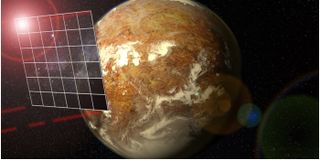
Paul M. Sutter is an astrophysicist at The Ohio State University , host of Ask a Spaceman and Space Radio , and author of " Your Place in the Universe. " Sutter contributed this article to Space.com's Expert Voices: Op-Ed & Insights .
Interstellar space travel . Fantasy of every five-year-old kid within us. Staple of science fiction serials. Boldly going where nobody has gone before in a really fantastic way. As we grow ever more advanced with our rockets and space probes, the question arises: could we ever hope to colonize the stars? Or, barring that far-flung dream, can we at least send space probes to alien planets, letting them tell us what they see?
The truth is that interstellar travel and exploration is technically possible . There's no law of physics that outright forbids it. But that doesn't necessarily make it easy, and it certainly doesn't mean we'll achieve it in our lifetimes, let alone this century. Interstellar space travel is a real pain in the neck.
Related: Gallery: Visions of Interstellar Starship Travel
Voyage outward
If you're sufficiently patient, then we've already achieved interstellar exploration status. We have several spacecraft on escape trajectories, meaning they're leaving the solar system and they are never coming back. NASA's Pioneer missions, the Voyager missions , and most recently New Horizons have all started their long outward journeys. The Voyagers especially are now considered outside the solar system, as defined as the region where the solar wind emanating from the sun gives way to general galactic background particles and dust.
So, great; we have interstellar space probes currently in operation. Except the problem is that they're going nowhere really fast. Each one of these intrepid interstellar explorers is traveling at tens of thousands of miles per hour, which sounds pretty fast. They're not headed in the direction of any particular star, because their missions were designed to explore planets inside the solar system. But if any of these spacecraft were headed to our nearest neighbor, Proxima Centauri , just barely 4 light-years away, they would reach it in about 80,000 years.
I don't know about you, but I don't think NASA budgets for those kinds of timelines. Also, by the time these probes reach anywhere halfway interesting, their nuclear batteries will be long dead, and just be useless hunks of metal hurtling through the void. Which is a sort of success, if you think about it: It's not like our ancestors were able to accomplish such feats as tossing random junk between the stars, but it's probably also not exactly what you imagined interstellar space travel to be like.
Get the Space.com Newsletter
Breaking space news, the latest updates on rocket launches, skywatching events and more!
Related: Superfast Spacecraft Propulsion Concepts (Images)
Speed racer
To make interstellar spaceflight more reasonable, a probe has to go really fast. On the order of at least one-tenth the speed of light. At that speed, spacecraft could reach Proxima Centauri in a handful of decades, and send back pictures a few years later, well within a human lifetime. Is it really so unreasonable to ask that the same person who starts the mission gets to finish it?
Going these speeds requires a tremendous amount of energy. One option is to contain that energy onboard the spacecraft as fuel. But if that's the case, the extra fuel adds mass, which makes it even harder to propel it up to those speeds. There are designs and sketches for nuclear-powered spacecraft that try to accomplish just this, but unless we want to start building thousands upon thousands of nuclear bombs just to put inside a rocket, we need to come up with other ideas.
Perhaps one of the most promising ideas is to keep the energy source of the spacecraft fixed and somehow transport that energy to the spacecraft as it travels. One way to do this is with lasers. Radiation is good at transporting energy from one place to another, especially over the vast distances of space. The spacecraft can then capture this energy and propel itself forward.
This is the basic idea behind the Breakthrough Starshot project , which aims to design a spacecraft capable of reaching the nearest stars in a matter of decades. In the simplest outline of this project, a giant laser on the order of 100 gigawatts shoots at an Earth-orbiting spacecraft. That spacecraft has a large solar sail that is incredibly reflective. The laser bounces off of that sail, giving momentum to the spacecraft. The thing is, a 100-gigawatt laser only has the force of a heavy backpack. You didn't read that incorrectly. If we were to shoot this laser at the spacecraft for about 10 minutes, in order to reach one-tenth the speed of light, the spacecraft can weigh no more than a gram.
That's the mass of a paper clip.
Related: Breakthrough Starshot in Pictures: Laser-Sailing Nanocraft to Study Alien Planets
A spaceship for ants
This is where the rubber meets the interstellar road when it comes to making spacecraft travel the required speeds. The laser itself, at 100 gigawatts, is more powerful than any laser we've ever designed by many orders of magnitude. To give you a sense of scale, 100 gigawatts is the entire capacity of every single nuclear power plant operating in the United States combined.
And the spacecraft, which has to have a mass no more than a paper clip, must include a camera, computer, power source, circuitry, a shell, an antenna for communicating back home and the entire lightsail itself.
That lightsail must be almost perfectly reflective. If it absorbs even a tiny fraction of that incoming laser radiation it will convert that energy to heat instead of momentum. At 100 gigawatts, that means straight-up melting, which is generally considered not good for spacecraft.
Once accelerated to one-tenth the speed of light, the real journey begins. For 40 years, this little spacecraft will have to withstand the trials and travails of interstellar space. It will be impacted by dust grains at that enormous velocity. And while the dust is very tiny, at those speeds motes can do incredible damage. Cosmic rays, which are high-energy particles emitted by everything from the sun to distant supernova, can mess with the delicate circuitry inside. The spacecraft will be bombarded by these cosmic rays non-stop as soon as the journey begins.
Is Breakthrough Starshot possible? In principle, yes. Like I said above, there's no law of physics that prevents any of this from becoming reality. But that doesn't make it easy or even probable or plausible or even feasible using our current levels of technology (or reasonable projections into the near future of our technology). Can we really make a spacecraft that small and light? Can we really make a laser that powerful? Can a mission like this actually survive the challenges of deep space?
The answer isn't yes or no. The real question is this: are we willing to spend enough money to find out if it's possible?
- Building Sails for Tiny Interstellar Probes Will Be Tough — But Not Impossible
- 10 Exoplanets That Could Host Alien Life
- Interstellar Space Travel: 7 Futuristic Spacecraft to Explore the Cosmos
Learn more by listening to the episode "Is interstellar travel possible?" on the Ask A Spaceman podcast, available on iTunes and on the Web at http://www.askaspaceman.com . Thanks to @infirmus, Amber D., neo, and Alex V. for the questions that led to this piece! Ask your own question on Twitter using #AskASpaceman or by following Paul @PaulMattSutter and facebook.com/PaulMattSutter .
Follow us on Twitter @Spacedotcom or Facebook .
Join our Space Forums to keep talking space on the latest missions, night sky and more! And if you have a news tip, correction or comment, let us know at: [email protected].
Paul M. Sutter is an astrophysicist at SUNY Stony Brook and the Flatiron Institute in New York City. Paul received his PhD in Physics from the University of Illinois at Urbana-Champaign in 2011, and spent three years at the Paris Institute of Astrophysics, followed by a research fellowship in Trieste, Italy, His research focuses on many diverse topics, from the emptiest regions of the universe to the earliest moments of the Big Bang to the hunt for the first stars. As an "Agent to the Stars," Paul has passionately engaged the public in science outreach for several years. He is the host of the popular "Ask a Spaceman!" podcast, author of "Your Place in the Universe" and "How to Die in Space" and he frequently appears on TV — including on The Weather Channel, for which he serves as Official Space Specialist.
Space mining startup AstroForge aims to launch historic asteroid-landing mission in 2025
Lego Technic planet earth and moon in orbit review
Japanese company to deorbit big hunk of space junk by 2029
Most Popular
- 2 StarFOX autonomous satellite swarm could level up space exploration
- 3 3 decades of satellite images show how cities keep getting higher
- 4 What is the 'Offspring' creature in the 'Alien: Romulus' finale?
- 5 200 meteorites on Earth traced to 5 craters on Mars
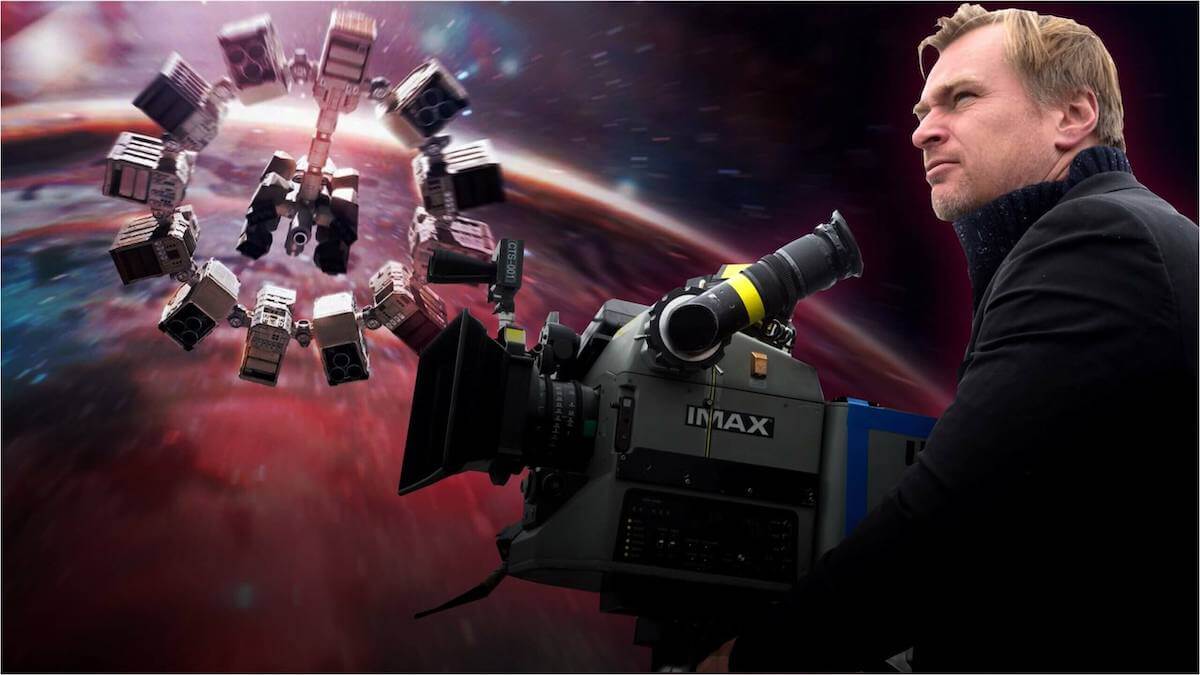
- Scriptwriting
Interstellar Explained — Plot, Meaning & the Ending Explained
T here’s no doubt about it: Interstellar was one of the most mentally-stimulating blockbusters of the 2010s. As such, a lot of people were confused about the Interstellar plot, high-concept science, and bold ending. It’s time for Interstellar explained – a deep-dive in which we answer some of the biggest questions audiences asked about the film. By the end, you’ll know the plot and meaning like the back of your hand; you might even say we’ll have an “interstellar explanation” for the fourth dimension.
Interstellar Ending Explained & Beat Sheet Breakdown
Subscribe for more filmmaking videos like this.
Interstellar Explanation
Interstellar plot and summary.
Interstellar is a 2014 movie that was directed by Christopher Nolan and written by Christopher Nolan and Jonathan Nolan . The film received four Academy Award nominations for Best Original Score, Best Production Design, Best Sound Mixing, and Best Sound Editing – and the VFX (Visual Effects) were so well regarded that they won the Oscar for Best Visual Effects.
Although Interstellar received good-not-great reviews upon release, it’s since garnered more acclaim and it frequently places on lists of the best sci-fi movies ever made .
Interstellar is about Earth’s last chance to find a habitable planet before a lack of resources causes the human race to go extinct. The film’s protagonist is Cooper (Matthew McConaughey), a former NASA pilot who is tasked with leading a mission through a wormhole to find a habitable planet in another galaxy.
Dr. Brand (Michael Caine) explains to Cooper that NASA previously sent another group (Lazarus) to find a habitable planet but they’ve gone silent.
Interstellar Movie Meaning • Dr. Brand Explains the Plan
There are two plans in the Interstellar plot:
- Plan A involves Cooper transmitting quantum data back to Earth in order to develop a gravitational propulsion theory that will allow spacecrafts to carry people off Earth into the other galaxy.
- Plan B involves Cooper’s crew finding the remaining Lazarus crew and establishing a colony on another world.
Interstellar Summary & Setting
When is interstellar set.
We don’t know for certain when Interstellar is set, but the script implies that it takes place in the not-so-distant future. We imported the Interstellar script into StudioBinder’s screenwriting software to take a closer look at the film’s setting. This scene takes place near the beginning of the story and gives us a good hint at how many years in the future Interstellar is set.
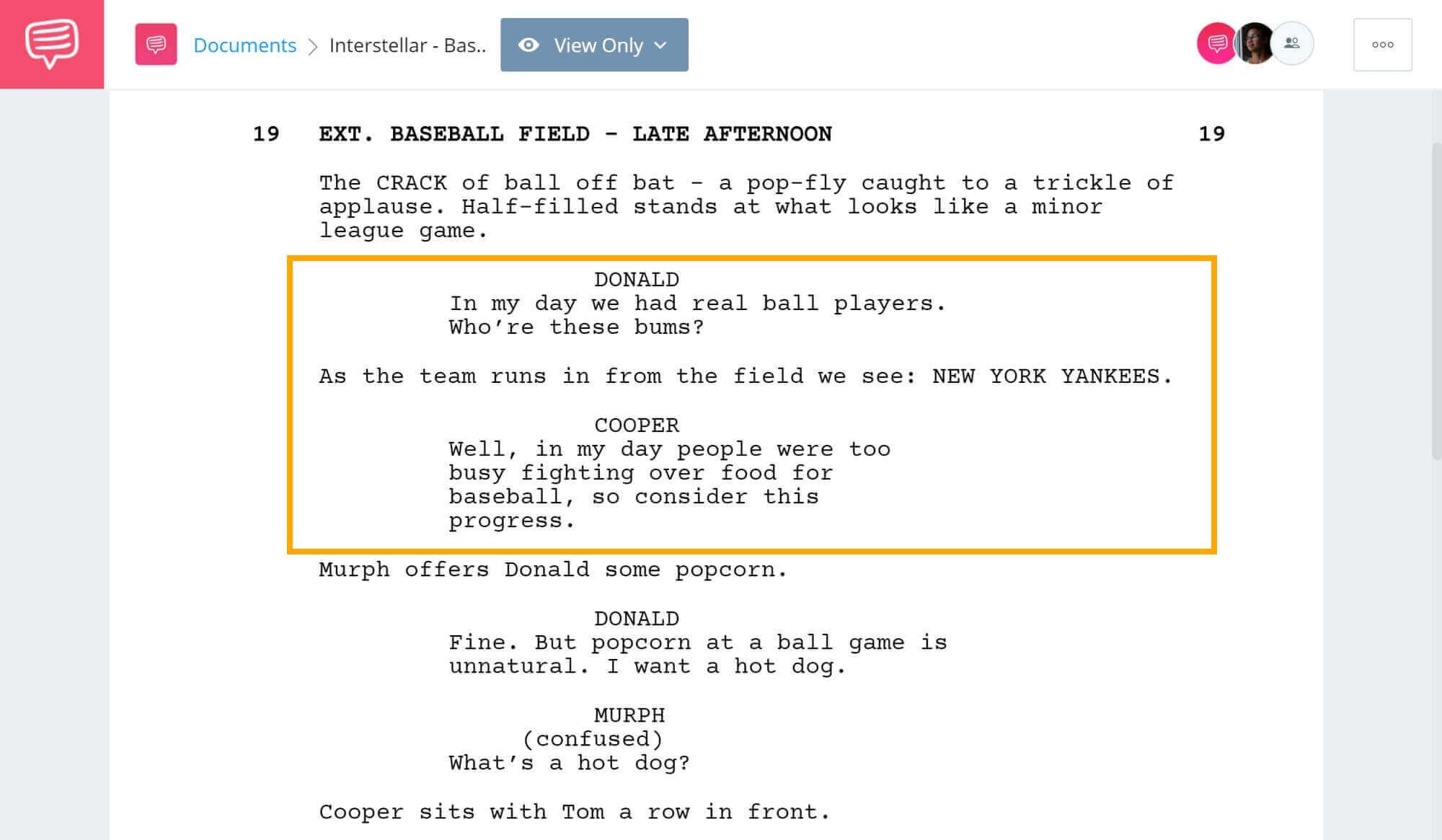
Read the Interstellar Baseball Scene
We can infer by way of deductive reasoning that Interstellar takes place about 40-70 years into the future. How? Well, we know that Major League Baseball was still played when Donald was a kid. And we know that when Cooper was a kid, things were in such a state of disarray that no baseball was played.
So, if we assume that Cooper is about 40, and that things fell apart sometime before he was born, but not so far before that Donald didn’t live through a period of normalcy, then we can deduce that Interstellar is set between the ages of Donald and Cooper — roughly 40-70 years from “modern time” of 2014.
Water Planet - Interstellar Explained
What happens on the water planet.
The Endurance crew decides to scout out Miller’s planet because it was the one that had most recently transmitted data to them. But since the planet is so close to the black hole, time is extremely dilated — every hour on the water planet is equivalent to seven years on Earth.
Cooper, Brand (Anne Hathaway), and Doyle (Wes Bentley) land on the surface and attempt to locate Miller’s transponder. But just as Brand finds the device, a massive wave rolls in, forcing the crew to flee to the courier ship. Doyle dies but Cooper and Brand narrowly escape — and Brand realizes that Miller must’ve died seconds before they arrived because of the severe time dilation.
Cooper’s Family - Interstellar Explained
What happens to cooper’s family.
Cooper leaves his family – daughter Murph (Mackenzie Foy/Jessica Chastain), son Tom (Timothee Chalamet/Casey Affleck) and father in-law Donald (John Lithgow) – on Earth in order to lead the NASA mission. In his absence, his family develops a contentious relationship; but we don’t learn about it until Cooper does, 23 years into the future while watching old transmissions.
Interstellar • Screenplayed
Murph and Tom become foil characters , aka characters who serve to expose attributes in each other. Murph becomes a NASA researcher who desperately wants to solve the gravitational theory to save the people on Earth while Tom takes over the family farm and largely rejects science and the reality of his situation. Their two opposing worldviews work against each other and expose negative and positive aspects of their character.
Mann’s Planet - Interstellar Explained
Where did matt damon come from.
Matt Damon plays the role of Dr. Mann, the captain of the Lazarus mission. After the failure of the water planet mission, Cooper is left with a difficult choice – go to Dr. Edmunds’ planet or Dr. Mann’s planet.
Let’s go back to the script to read through one of the best scenes – the one in which Cooper has to make the right decision in order to have any hope of executing the mission.
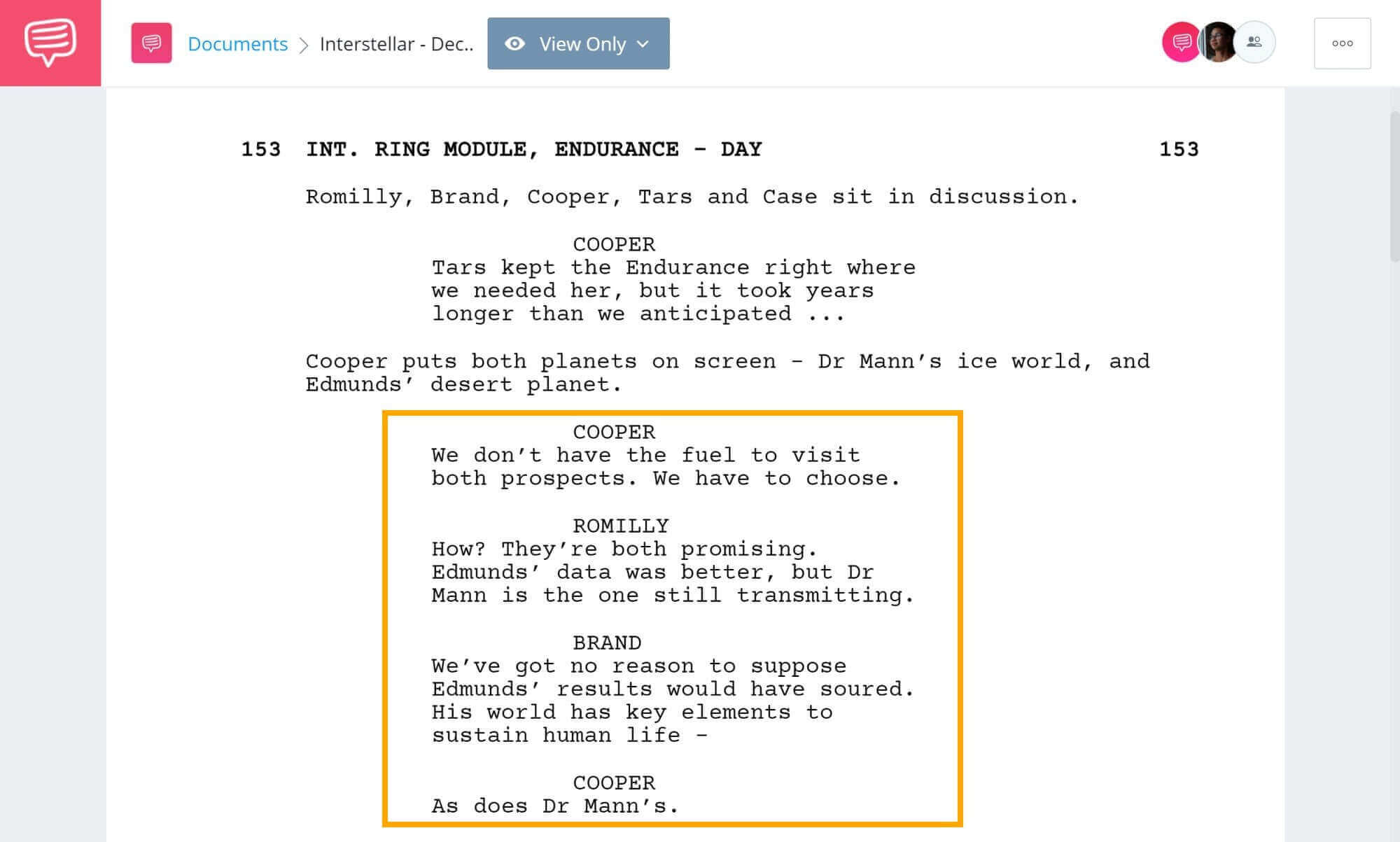
Read the Interstellar Decision Scene
Cooper chooses Mann’s planet, taking the Endurance on a one-way trip to Matt Damon Town. When the crew arrives, they find Mann in cryosleep. It’s pretty much clear from the get-go that something is wrong with Mann – although considering the fact that he’s been in solitude/cryosleep for years, it’s not hard to see why.
But Mann has more than just a case of cabin fever, he’s full-blown bent on finishing the mission, no matter the cost.
Interstellar Summary
Plan a was a sham.
Back on Earth, Dr. Brand reveals to Murph that Plan A was always a sham and there’s no way the people of Earth could ever escape.
Interstellar Meaning • Plan A Was a Sham
Murph transmits a message to Cooper accusing him of knowing Plan A wasn’t possible, effectively leaving her to die. Cooper tells Mann, Brand and Romilly that he’s going to return to Earth to be with his children and the rest of them can stay on Mann’s planet to start a colony.
But Mann’s planet isn’t hospitable – and he needs the ship to go to Edmunds’ planet. In this scene, Nolan intercuts between Cooper’s confrontation with Mann and Murph’s confrontation with Tom.
Interstellar Movie Plot Explained • Dual Confrontations
Murph burns all of the crops in order to make Tom understand he needs to leave the farm. Romilly is killed by a trap mine. Brand and Cooper barely escape back to the Endurance.
What happens in the docking scene?
Interstellar Movie Meaning • Docking Scene
I love Interstellar but, boy oh boy, we’ve got a cringe-worthy exchange of dialogue here:
TARS: Cooper, it’s not possible.
COOPER: No, it’s necessary.
Not great – but it’s hard to pick holes in a script as sharp as Interstellar . After some impressive piloting, Cooper successfully docks his courier ship in the Endurance.
What is the Interstellar black hole?
The Interstellar black hole is called “Gargantua” due to its gargantuan size. For more on how Nolan and the team made Gargantua with CGI (computer generated imagery), check out this awesome video.
Interstellar Theory • Building a Black Hole
When Interstellar was released in 2014, there were no recorded images of a black hole. But in 2019, the Event Horizon Telescope took the first images of a black hole. This is what the central black hole of Messier 87 (a galaxy in the Virgo cluster) looks like.
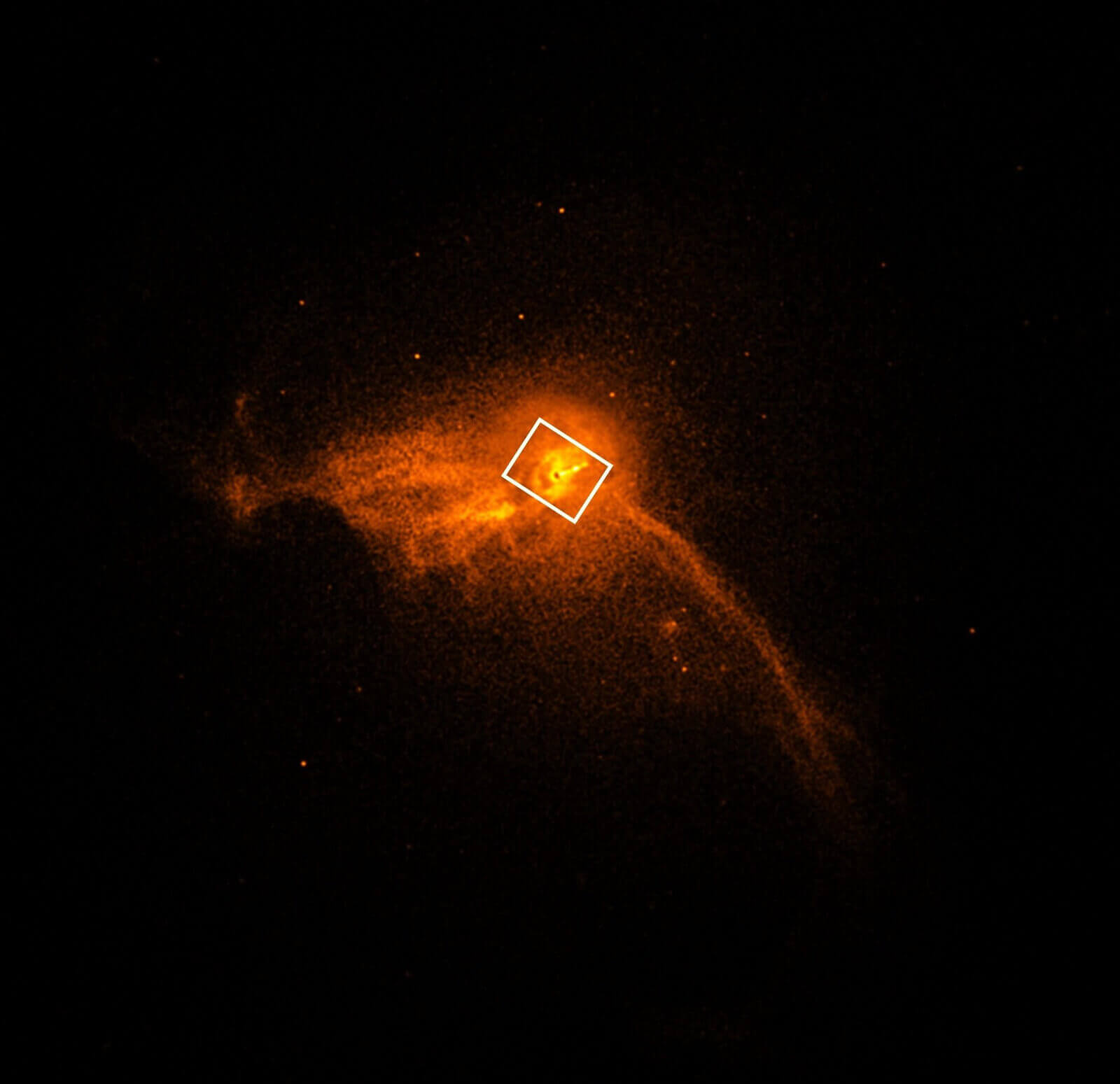
Messier 87 Black Hole via NASA
As it turns out, the scientists and visual artists who worked on Interstellar were pretty close with the design of the black hole. But what is a black hole? To answer that question, we have to first answer the question: what is a wormhole? And to answer that, let’s watch a great analogical scene from the film.
Interstellar Movie Plot Explained • Wormholes
A common misconception is that black holes and wormholes are the same thing. But as Romilly (David Gyasi) explains, wormholes are like funnels that connect two distant points in spacetime. Hypothetically, objects could safely travel through a wormhole – but consequently, black holes are areas of spacetime that have such strong gravity that nothing can escape.
Note: I am not a PhD physicist and most of the astronomical science in Interstellar is theoretical.
Breaking Down the Interstellar Black Hole
Interstellar black hole explained.
I think the Interstellar black hole scene is where a lot of people got lost. Up until that point, everything made a good amount of sense:
- Wormholes allow people to travel long distances through spacetime
- Differences in gravity and relative velocity cause time dilation
- Planets need key life-sustaining elements to be hospitable
But the Interstellar black hole scene is where Nolan dove deep into theory – and there’s no way to tell whether he was “right” or “wrong” because we have no idea what exists beyond the event horizon.
The event horizon, as it relates to Einstein’s theory of relativity, is the point in a black hole where nothing can escape nor be observed.
So, for Interstellar, Nolan said, “Let’s send Cooper beyond the event horizon and see what happens.” Let’s look to the film to see what happened — it's abstract and minimalist but a truly thrilling sequence.
Interstellar Gargantua Explained
Many theoretical physicists believe that the event horizon serves as a barrier to the unknown physics of a black hole’s singularity. It could be compressed spacetime, antimatter, etc. In the case of Interstellar, the singularity is a portal to the fourth dimension. But what is the fourth dimension? Let’s listen to Carl Sagan explain.
Carl Sagan Explains the 4th Dimension
So if we’re really trapped inside of a fourth dimension, how can we escape? Well, perhaps the answer exists beyond the event horizon.
Interstellar Movie Explained
Interstellar ending explained.
How does Interstellar end? In order to save Brand, Cooper slingshots around Gargantua to generate enough energy to send the Endurance to Edmunds’ planet. As a result, he slips into the black hole and beyond the event horizon. There, he finds himself trapped in the fourth dimension – a tesseract styled as a never-ending bookshelf.
Interstellar Ending Scene Explained
But Cooper realizes that he’s able to interact with Murph through spacetime. He asks TARS to relay the quantum data to him, which he communicates through morse code. Murph picks up on the morse code because she was fascinated by the gravitational anomalies in their house ever since she was a kid.
Turns out, those anomalies were caused by Cooper interacting through another dimension – sending himself on a mission to get the quantum data. Don’t just take my word for it – for more on the Interstellar ending explained, let’s listen to Neil deGrasse Tyson.
deGrasse Tyson Interstellar Last Scene Explained
The questions raised in this scene aren’t just plot-filler, they’re some of the most profound questions in the universe – epistemological themes, or stances taken on how we understand the world are hallmarks of Christopher Nolan’s directing style .
Interstellar Movie Explained (Continued)
Interstellar ending explained: part ii.
After Cooper successfully communicates the quantum data to Murph, he’s kicked out of the tesseract. Some time later, he wakes up on “Cooper Station” – a space station that’s orbiting Saturn. There he finds Murph on her deathbed; having saved humanity from extinction with the quantum data. Let’s read through their final conversation together.
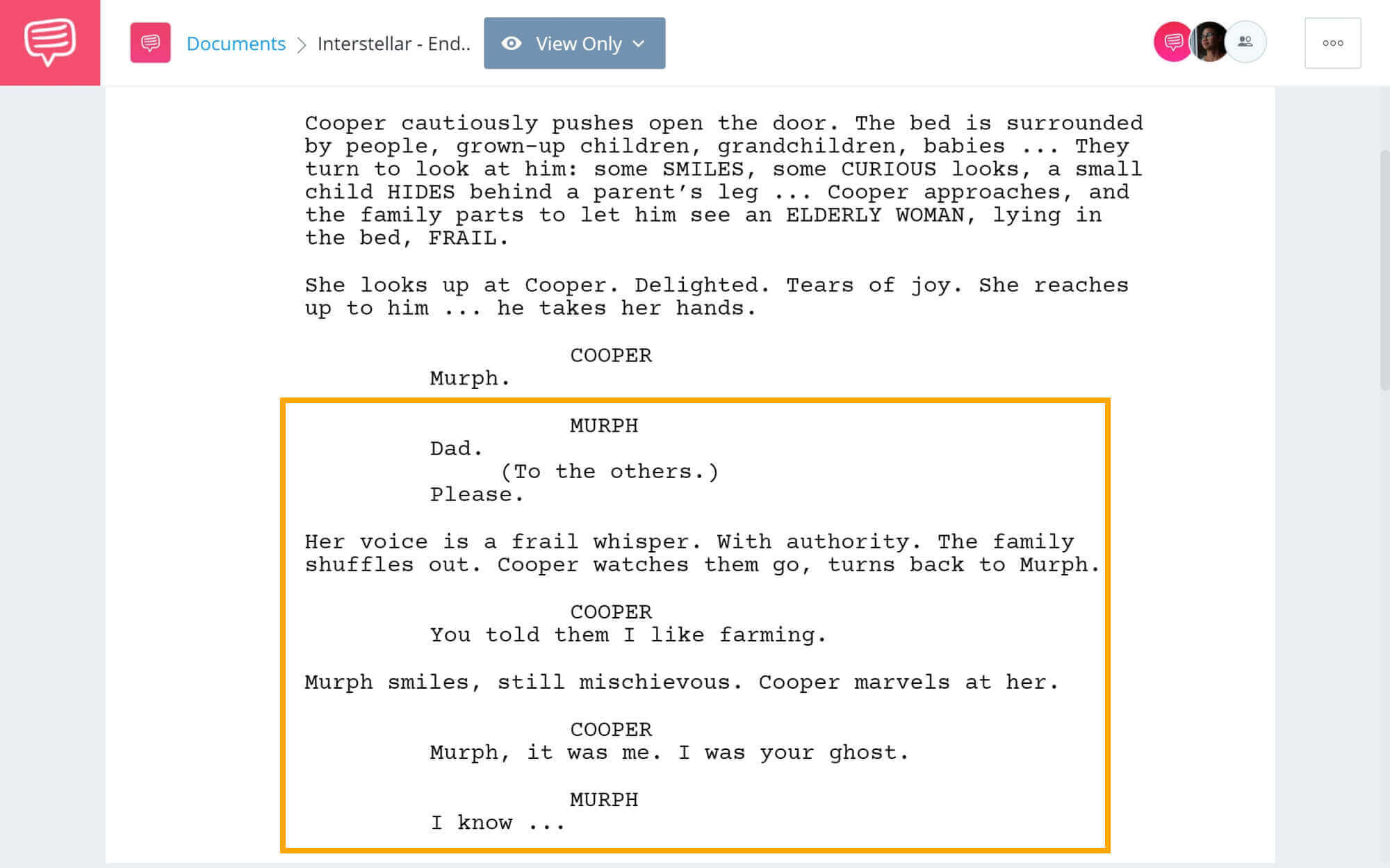
Read the Interstellar Ending Scene Explained
The Interstellar meaning lies somewhere between astronomical science and intimate human connection. It’s simultaneously a story about traversing the stars and fighting for what you love. For many critics, it’s this dual-narrative structure that makes the story so good – even if it can be a little scientifically vague and cheesy.
Related Posts
- Read More: Inception Ending Explained →
- Mastering the Shot List Like Christopher Nolan →
- How Nolan Uses Circles to Warp Sight & Sound →
What is Tenet About?
Interstellar isn’t the only Christopher Nolan movie that left audiences scratching their heads. His 2020 film Tenet is just as, if not more confounding than Interstellar . In this next article, we break down the plot of Tenet and analyze some of the film’s biggest events.
Up Next: Tenet Movie Plot Explained →
Write and produce your scripts all in one place..
Write and collaborate on your scripts FREE . Create script breakdowns, sides, schedules, storyboards, call sheets and more.
- Pricing & Plans
- Product Updates
- Featured On
- StudioBinder Partners
- Ultimate Guide to Call Sheets
- How to Break Down a Script (with FREE Script Breakdown Sheet)
- The Only Shot List Template You Need — with Free Download
- Managing Your Film Budget Cashflow & PO Log (Free Template)
- A Better Film Crew List Template Booking Sheet
- Best Storyboard Softwares (with free Storyboard Templates)
- Movie Magic Scheduling
- Gorilla Software
- Storyboard That
A visual medium requires visual methods. Master the art of visual storytelling with our FREE video series on directing and filmmaking techniques.
We’re in a golden age of TV writing and development. More and more people are flocking to the small screen to find daily entertainment. So how can you break put from the pack and get your idea onto the small screen? We’re here to help.
- Making It: From Pre-Production to Screen
- How to Make a Production Call Sheet From Start to Finish
- What is Call Time in Production & Why It Matters
- How to Make a Call Sheet in StudioBinder — Step by Step
- What is a Frame Narrative — Stories Inside Stories
- What is Catharsis — Definition & Examples for Storytellers
- 91 Facebook
- 5 Pinterest
- 62 LinkedIn
Seriously Photography
‘Interstellar’ Explained: Timeline, Ending, Themes, and Meaning

Interstellar is loud, sentimental, and filled with advanced scientific theories that work for the story, but are mostly theoretical in real life. I’m not one of those people who sit down to pluck apart the scientific plausibility of a screenplay unless I think it takes away from the story. In the case of Interstellar , I think it adds to it.
Interstellar juggles many different timeframes for the story. We cross from what’s going on within Earth to the surface level of foreign planets, to the circling ship, and then to a fifth dimension that unites all of them. That’s a lot to explain, so we’re going to try to do it together.
Today, I want to get into the meaning and explanation for the movie Interstellar and even go over what happens in the movie. We’ll talk about Jonathan Nolan and Christopher Nolan working on the movie together and examine its ongoing themes. I’m excited to dive into this one.
So let’s get started.
The Interstellar Movie: Explained
Christopher Nolan is one of the most interesting directors out there. He tackles huge concepts and doesn’t dumb them down. A lot of times the audience is working to learn along with the characters, and on the edge of our seats as certain plot points jump out. Let’s go through the summary of Interstellar and then tackle explaining the movie and the Interstellar premise.
The Interstellar movie characters
- Matthew McConaughey as Joseph Cooper, a widower and NASA pilot who became a farmer.
- Anne Hathaway as Dr. Amelia Brand, a NASA scientist, and astronaut
- Mackenzie Foy as young Murph
- Ellen Burstyn as old Murph
- John Lithgow as Donald, Cooper’s elderly father-in-law
- Michael Caine as Professor John Brand, a high-ranking NASA scientist, ideator of Plan A, former mentor of Cooper, and father of Amelia
- David Gyasi as Romilly, another high-ranking NASA member, and Endurance crew member
- Wes Bentley as Doyle, a high-ranking NASA member, and Endurance crew member
- Timothée Chalamet as young Tom
- Matt Damon as Mann, a NASA astronaut sent to an icy planet during the Lazarus program
- Bill Irwin as TARS (voice and puppetry) and CASE (puppetry)
- Josh Stewart as CASE (voice)
- Topher Grace as Getty, Murph’s colleague and love interest
- Leah Cairns as Lois, Tom’s wife
- David Oyelowo as School Principal
- Collette Wolfe as Ms. Hanley
- William Devane as Williams, another NASA member
- Elyes Gabel as Administrator
- Jeff Hephner as Doctor
- Russ Fega as Crew Chief
Interstellar plot and summary
The year is 2067, and crop shortages and dust storms have devastated humanity. We meet Cooper, a widower, engineer, and former NASA pilot. Now he’s a mediocre farmer. He and his two kids live with his father-in-law, Donald. His kids are the teenage son, Tom, and his 10-year-old daughter, Murph.
A terrible dust storm leaves a pattern on Murph’s bedroom floor. Murph thinks a ghost created them, but the scientific-minded Cooper realizes the patterns were made by gravity variations. After some math, he thinks they represent geographic coordinates in binary code. Cooper and Murph follow the coordinates to a secret NASA facility headed by Professor John Brand, whom Cooper knows from his past life working at NASA.
The NASA scientists fill them in on what’s been going on. Forty-eight years ago, unknown beings placed a wormhole near Saturn, opening a path to a distant galaxy with 12 potentially habitable worlds located near a supermassive black hole named Gargantua. Twelve volunteers traveled through the wormhole to survey the planets, and three—Dr. Mann, Laura Miller, and Wolf Edmunds—reported positive results. The rest are presumed dead.
Brand presents them with two plans to ensure humanity’s survival. Plan A involves developing an antigravitational propulsion theory to propel settlements into space. That is years ahead of the science they have and seems futile. In contrast, Plan B involves launching the Endurance spacecraft carrying 5,000 frozen human embryos to settle on a habitable planet and commence repopulation from there. Then other humans will follow.
Cooper is one of the only pilots left on Earth who can complete a mission like Plan B, so he decides to lead the charge, leaving his family behind. Also going are Dr. Amelia Brand (Prof. Brand’s daughter), Dr. Doyle, and Romilly. Before leaving, Cooper gives an upset Murph his watch to track the time for when he returns. She’s so sad she won’t even say goodbye.
What happens on the water planet?
The wormhole takes the crew to Miller’s planet. Due to Gargantua’s proximity, time is severely dilated. Every hour on the planet equals seven Earth years. Romilly remains aboard Endurance to research Gargantua, while Cooper, Doyle, and Brand descend in a landing craft to investigate the water planet for one hour. The group finds Miller’s shipwreck just before a giant wave kills Doyle.
Cooper and Brand barely survive, and their delayed departure results in them reaching Endurance 23 years later in Earth time, though only a few hours for them.
What happens to Cooper’s family?
It’s a brutal blow to start the mission. Back aboard, Cooper is forced to watch videos to catch up on what’s happened in the 23 years he left earth. Seeing his kids grow, his father-in-law die, and even getting some grandkids. His son has become a farmer like his father-in-law. His daughter now works at NASA like him. They’re both doing their best to figure out what life is like without a dad.
Cooper and his crew are forced to soldier on. The crew travels to Mann’s planet, where they revive him from cryostasis.
Meanwhile, now a NASA scientist herself, Murph has transmitted a message claiming Cooper and Brand knew that Plan A was never viable because it required tech and data from inside the black hole. Cooper intends to return to Earth to be with his daughter, while Brand and Romilly will remain on Mann’s planet for permanent habitation. But in a big twist, Mann reveals that he sent falsified data to be rescued—the planet is not fit for human life. He attempts to kill Cooper and then steals a lander and heads for Endurance. Romilly is killed by a booby trap. Brand and Cooper pursue Mann in another lander.
What happens in the docking scene?
Mann is killed during a failed docking operation, severely damaging the ship Endurance.
Mann and Cooper manage to board, but now don’t have enough fuel to reach Edmunds’ planet—which is their last hope for finding a place for humanity to relocate. They do some complex math and decide to attempt a slingshot maneuver so close to Gargantua that time dilation adds another 51 years to the already long journey.
The Ending of Interstellar
Cooper and the robot TARS actually jettison from the rocket to shed weight and then propel Endurance so it can reach Edmunds’ planet. In turn, Cooper and TARS land inside a massive four-dimensional space called a tesseract.
As he drifts inside, Cooper sees through the bookcases of Murph’s old bedroom and weakly interacts with its gravity, realizing he was Murph’s “ghost.” He sent the coordinates.
The Interstellar bookshelf scene
Cooper theorizes that the tesseract was constructed by humans from the far future who have access to infinite time and space.
He thinks Cooper realizes he and TARS were brought there to relay information to Murph that is critical to the survival of humankind. Cooper uses gravitational waves to encode NASA’s coordinates in the dust patterns in Murph’s room before manipulating the second hand of Murph’s wristwatch using Morse code to transmit all the data that TARS collected from within Gargantua so that Plan A can work.
On Earth, the adult Murph realizes the “ghost” is her father and deciphers the message to solve for Plan A.
The Interstellar ending scene
The tesseract spits Cooper out, and he wakes up on a futuristic space habitat orbiting Saturn, where he reunites with an elderly Murph—who is on her deathbed. Using the quantum data Cooper sent, the younger Murph solved the gravitational theory for Plan A, enabling humanity’s exodus from Earth and transformation into a spacefaring civilization.
Murph urges Cooper to return to Brand to have the rest of his life. Her life is now complete. Cooper and TARS take a spacecraft to fly to Edmunds’ planet, where Brand prepares a base for Plan B.
Interstellar movie breakdown
Interstellar movie timeline infographic.
To actually understand all the timelines and to explain the movie Interstellar , I thought it might help to see the visuals.
This infographic is the work of Frametale , an entertainment marketing agency with offices in Los Angeles and Istanbul, led by creative director Dogan Can Gundogdu. They have work that’s appeared in lots of different films, commercials, and television shows. It explains the time dilation at the center of the story.
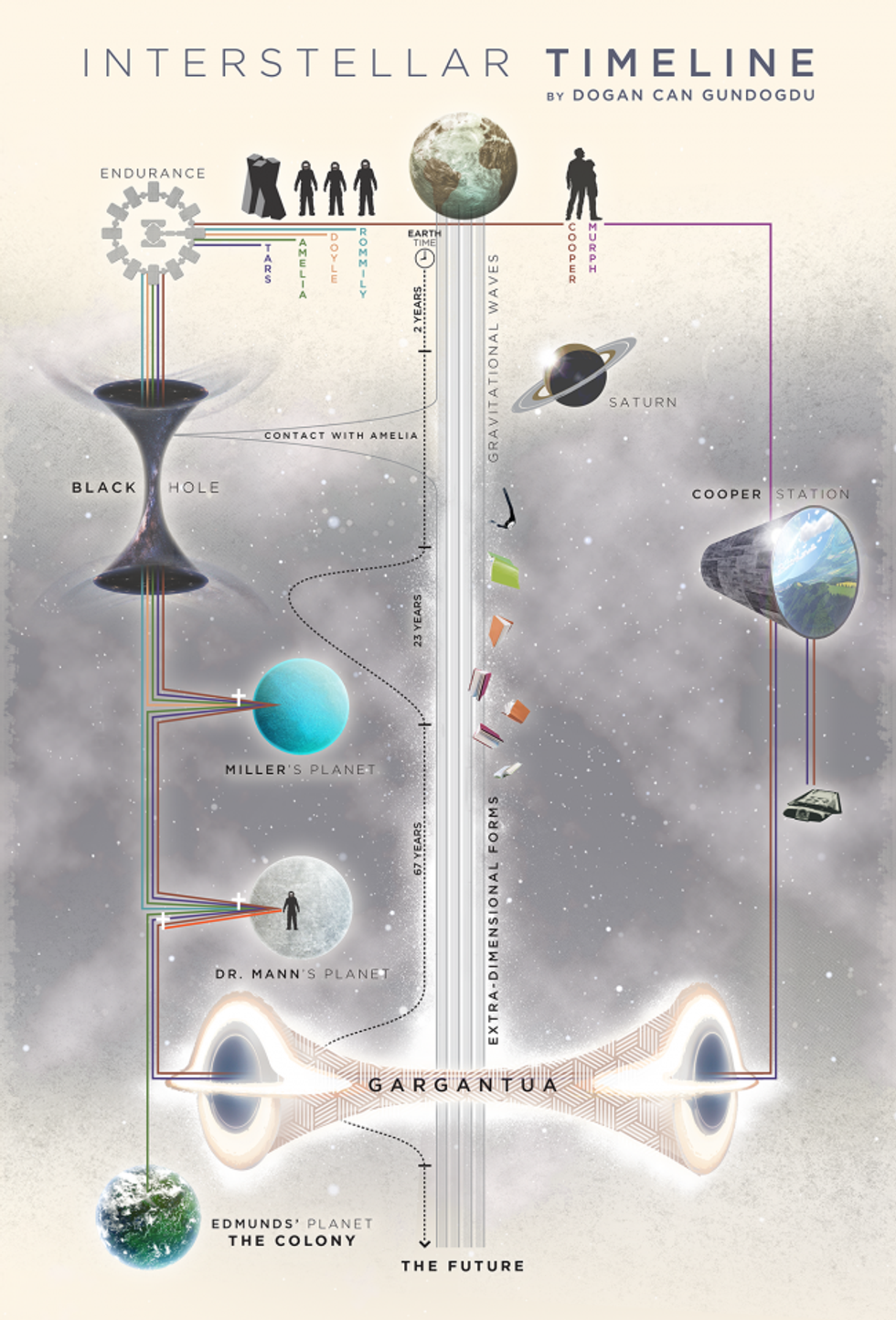
The Interstellar meaning and movie explanation
Set in a future where a failing Earth puts humanity on the brink of extinction, it sees a team of NASA scientists, engineers, and pilots attempt to find a new habitable planet via interstellar travel . Of course, the trip has a lot of bumps along the way. And we see humanity suffer as they try to become a multi-planetary species.
At its core, this is a movie about humanity’s sacrifices to survive. It’s about how pioneers are willing to lay down their own lives so that an entire species might go on.
At the center of this is one family, the Coopers, who dedicate their lives to space travel so that others might live.
What happened to Earth in Interstellar ?
Our pollutants made the earth unstable for human life, so everyone leaves to travel to another planet.
Does Brand die in interstellar ?
The older Dr. Brand does die during the pursuit of Plan A. The younger Dr. Brand is able to get to the Plan B planet and is waiting there for Cooper at the end of the movie.
How long was Cooper in space in Interstellar ?
While we don’t know the exact amount of time, you can guess by Murph’s age that he’s spent almost 100 years looking for planets, but to him, it may have only been a matter of weeks.
The theme of Interstellar and the movie’s meaning
For me, I think the themes of this movie lie in the story of family and survival. We’re all one humankind, and despite our differences, the ability to survive and move on should trump anything we have against each other.
We need to see past the problems and unite for the much bigger and much more important causes. When it comes to family, love can transcend generations and keep us united although far apart. Sometimes you have to sacrifice to make sure the best happens for you and your offspring.
Summarizing the Interstellar movie, explained
Hopefully, by reading all of these parts, you’ve gotten your biggest questions about the movie answered. It’s a deep journey into humanity and our quest to live amongst the stars. While the journey might be confusing with all the time jumps and multiple planets and plans, I think it just requires rewatching and concentration.
Roger Ebert once called film the ultimate empathy machine . It’s a window into all kinds of humanity. A way to see more of the world and to confront what makes us human.
It’s hard to find a better example of this sentiment than Nolan’s Interstellar . It’s a movie about the sacrifices we make to ensure humanity continues to survive, even as the lead character watches his own children die from afar. And somehow, humanity gets better for it, and his grandchildren get to live.
Let me know what you think in the comments.
Share this:
- Click to share on Facebook (Opens in new window)
- Click to share on X (Opens in new window)
Screen Rant
All 11 celestials in the mcu so far.

Your changes have been saved
Email is sent
Email has already been sent
Please verify your email address.
You’ve reached your account maximum for followed topics.
10 MCU Phase 1 Scenes That Aged Poorly
Mcu avengers characters imagined in disney's 2d animation style art is stunningly perfect, the mcu just cast its best kang replacement.
- Celestials are some of Marvel's oldest sentient beings, influencing cosmic events and creating life forms.
- Unique Celestials like Ego the Living Planet and Tiamut add diverse dynamics to the Marvel Universe.
- Arishem the Judge and others play pivotal roles in the franchise.
The Celestials are perhaps the single most powerful race in the Marvel Cinematic Universe , but there have been precious few examples of them throughout the franchise's many films. The grand cosmic beings are the single oldest sentient creatures in the Marvel Universe, having been responsible for the creation of the Eternals, Deviants, and many more life forms. As a result, the importance of the Celestials' role in Marvel's cosmology , both in the films and the comics, cannot be understated.
Typically appearing as humanoid giants inhabiting colorful suits of armor, the Celestials have a variety of forms and awe-inspiring galaxy-scale powers. In the comics, the spacefaring beings do much more than simply seed life in planets, acting as gatekeepers to interstellar travel that destroy or enhance entire races based on their own judgment. While the Celestials' role in the MCU might not be quite so present, they have made a multitude of appearances.
11 Ego The Living Planet
Guardians of the galaxy vol. 2 (2017).
A being of great cosmic significance, Ego is a remarkably different Celestial with his own set of goals and powers. Rather than appearing as a massive humanoid clad in jagged armor, Ego is a literal living planet, capable of conjuring and re-shaping matter and energy at a whim. Using these powers, Ego infiltrated the furthest corners of the galaxy, creating host bodies from which to conceive half-Celestial offspring in the hopes of using their doubled powers to conquer the galaxy in his image.
Because of his difference from the other Celestials, Ego's actual status as such was a topic of debate for some time. However, What If...? confirmed that Ego is a Celestial , despite how vastly unique he is. It seems as though his claims of springing into consciousness from the earliest days of existence are to be believed, as directly stated by The Watcher.
10 The Unknown Decapitated Celestial
First appeared in thor: the dark world (2013).
While not much is known about the Celestial that would later become the satellite Knowhere, the place itself has a storied history. Originally a haven for criminal organizations like the Tivan Group, looking to mine the rare organic components of the decaying Celestial skull, the literal Celestial body would eventually become the headquarters of the Guardians of the Galaxy, who outfitted it with massive engines to make it mobile. In the comics, the Celestial that would go on to form Knowhere was decapitated by Knull, king of the Symbiotes, but in the MCU, the origin of the severed head space station is still a mystery.
9 One Above All
Thor: love and thunder (2022).
Appearing only in statue form, the Celestial known as One Above All is possibly the single most powerful member of his race , or at least was. Alluded to in Eternity's temple in Thor: Love and Thunder , the character serves as the Celestials' leader in the comics, possibly occupying a similar role in the MCU's cosmology. Confusingly, the One Above All shares his title with another entity of the same name, an even more powerful being that essentially acts as the Marvel universe's true God and creator.
8 Arishem The Judge
Eternals (2021).
If the One Above All is the Celestials' leader and most powerful member in Marvel Comics, Arishem the Judge fulfills this position instead in the MCU. The Prime Celestial, Arishem is responsible for creating the universe as we know it , sewing the seeds for the formation of stars, galaxies, and other heavenly bodies, culminating in the creation of intelligent life. Arishem was also responsible for the creation of the Deviants, a race of ferocious creatures meant to protect intelligent life from predators before becoming predators themselves, and the Eternals, immortal beings later created to stop the out-of-control Deviants.
However, the true purpose behind Arishem's plan was the creation of new Celestials, which Emerged from seeded planets in order to further spread life throughout the universe. The only reason Arishem wanted sapient life to develop and flourish was to feed the birth of fresh Celestials, such as Tiamut the Communicator, whose Emergence would destroy the planet. In the comics, Arishem's role was more closely aligned to his title, judging whether various civilizations should live or die, with the One Above All acting as the Prime Celestial instead.
7 Nezarr The Calculator
Another Celestial billions of years old, Nezarr the Calculator was another of the ancient race, shown to Sersi when she took over the role of Prime Eternal. With his signature blue armor, Nezarr gracefully navigated the cosmos, his work like incomprehensible to mortal minds. In the comics, Nezarr the Calculator was responsible for gathering and interpreting the vast amounts of data corresponding to emergent galactic civilizations, feeding it to Arishem for judgment.
6 Eson The Searcher
Guardians of the galaxy (2014).
Clad in purple armor, Eson the Searcher showed off to the Guardians of the Galaxy just how staggeringly powerful the Celestials' destructive capabilities are. Using his staff to harness the awesome might of the Power Stone , Eson is shown obliterating the entire surface of a planet with one strike, ruthlessly ending an entire civilization for unknown reasons. In the source material, Eson's job isn't so violent, instead living up to his name as a purveyor of planets, being the first Celestial to discover Earth.
5 Jemiah The Analyzer
Jemiah the Analyzer is among the first Celestials shown to Sersi, seen creating the stars that led to the formation of the galaxy and life itself. Once again, the comics version of Jemiah the Analyzer pays closer attention to his title, analyzing the various civilizations the Celestials had seeded throughout the cosmos and reporting them back to Arishem. In the MCU, his name also comes up on Knowhere, with the satellite's popular bar, Jemiah's Boot, being named after him.
4 Hargen The Measurer
Relatively younger compared to the other Celestials, Hargen is counted among those of the race who had emerged from seeded planets thanks to the life-force of intelligent species, proof of Arishem's plan working. A particularly huge and brutish-looking Celestial in his green armor, Hargen helps his fellow Celestials create stars and other cosmic bodies later on. Of course, in the comics, Hargen the Measurer does indeed measure things, assessing the planets within the Celestials' cosmic survey.
3 Tiamut The Communicator
Meant to emerge from the Earth, Tiamut the Communicator was supposed be the newest Celestial born with the destruction of humanity, feeding off of the latent energy of the species' developed minds. Luckily for the human race, the Eternals chose to save humanity at the cost of Tiamut's life, leaving the massive being stillborn and half-formed in the Indian Ocean, having been transmuted into stone by Sersi . In the comics, Tiamut is similarly trapped within the Earth, being sealed under California's Diablo Mountains to become known as the Dreaming Celestial.
Captain America: Brave New World looks set to explore more about Tiamut, with the Celestial's transmuted body seemingly set to introduce adamantium to the MCU . However, it's unclear if Sersi transmuted the entire Celestial to adamantium, if Tiamut's Celestial body was always partially made from adamantium, or if there's something else at play. Whatever the case, though, this storyline appears set to make Tiamut a focal point of the MCU's overarching story again, and tie the Celestials once more into the main narrative of the Multiverse Saga.
First appeared in Guardians of the Galaxy Vol. 2 (2017)
Appearing as a humanoid member of an unknown alien race, Mantis was raised alone by Ego the Living Planet since childhood, who utilized her abilities of emotional manipulation to help him sleep and control his neurotic tendencies. In The Guardians of the Galaxy Holiday Special , Mantis revealed that she, too, was a child of Ego, and thus a half-Celestial alongside her half-brother, Peter Quill. This was a major reveal, as the storyline is new to the MCU, and one that Mantis had kept private since her introduction in Guardians Of The Galaxy Vol. 2 in 2017.
Unlike Quill, Mantis seems to have inherited none of Ego's Celestial powers, with her empath abilities being a result of her biology via her antennae and still working after Ego's death. In the comics, Mantis is actually a human who lived with the Kree, rather than a half-Celestial alien.
1 Peter Quill
First appeared in guardians of the galaxy (2014).
For the longest time, both audiences and Peter Quill himself thought him to be simply a normal human boy with an absent father, abducted by aliens after the death of his mother. However, Guardians of the Galaxy Vol. 2 revealed that his father was actually the Celestial Ego the Living Planet. Peter is significant for being the only known offspring of Ego to inherit any of his father's powers , showing the same abilities to manipulate matter. His powers seemed to be tied to Ego himself, fading away with the death of his father.
Peter's Celestial powers were hinted at earlier in the first Guardians of the Galaxy, when he managed to withstand bare contact with the ravaging cosmic forces of the Power Stone. This half-Celestial heritage represents a major departure from the comics, in which the ancient cosmic entities are incapable of mating with lesser life forms - and in which Peter Quill is in no way related to Ego the Living Planet, though Ego does have a planetary family of sorts.
Originally, Star-Lord was half Spartax, an advanced race of aliens nearly indistinguishable from humans. It's safe to say that the MCU take on Star-Lord's heritage is much more compelling, and provides the franchise an opportunity to delve more into the lore of not only Ego but also the Celestials in general by making the specific adjustments to the overall lore that it has thus far.
While it's unclear if Quill's parentage will ever come up in storylines again now both his parents have passed, his Celestial father may well crop up to put him on the wrong side of the anti-alien legislation that cropped up at the end of Secret Invasion . As such, while Star-Lord's Celestial lineage may no longer be a focus in the MCU , it could still play a key role in the character's future.
Marvel Cinematic Universe
The Marvel Cinematic Universe is a multimedia superhero franchise that began in 2008 with Paramount's Iron Man starring Robert Downey Jr. The franchise quickly grew in popularity, with Disney eventually buying out Marvel Entertainment in 2009. The MCU consists of dozens of movies and TV shows, most notably Avengers: Endgame, WandaVision, and Loki.
Upcoming MCU Movies
Captain america: brave new world, thunderbolts*, the fantastic four (2025), blade (2025), avengers: doomsday, avengers: secret wars.

Why is Interstellar releasing in theatres again in 2024? Explained
A s Interstellar completes 10 years, the epic science fiction drama by Christopher Nolan gets ready for a re-release in theatres. Originally released in October 2014, it blew the minds of the audience with its thought-provoking storyline and an iconic score from Hans Zimmer.
The re-release, which was pegged for a September 2024 date, has now been pushed back to December. With over grosses of $681 million worldwide, this masterpiece had been showered with panegyrics from critics worldwide.
The re-release of Interstellar lets fans relive its cinematic experience but introduces it to newer generations of moviegoers.
Interstellar receives re-release for 10th anniversary
Of course, there are many reasons, but the most appropriate one about the re-release is that Interstellar will celebrate its 10th anniversary since its first release.
The film has modernized itself to a certain extent as a classic in the science fiction genre, admired and liked by many for its bold narrative, innovative visual effects, and powerful music by Hans Zimmer.
Directed by Christopher Nolan, Interstellar dwells on themes like space exploration, human survival and the twisted nature of time, literally sticking audiences and critics at the bottom of their seats.
The rer=elease also becomes a nod towards Nolan's dedication to the preservation of the cinematic experience. Known for staying true to the film, and, even more so, adhering to Imax technology, Nolan ensures that Interstellar is presented in its original format: breathtakingly beautiful.
In bringing back the film into theatres, especially onto 70mm IMAX, audiences will be allowed to relive that same sensory and emotional experience that catapulted the movie into landmark status in contemporary cinema.
The Legacy of Interstellar
Interstellar is known for the combination of complex scientific themes and an emotional storyline. The film is based on events occurring in a future period when Earth has become non-sustainable.
The film follows astronauts who travel through a wormhole close to Saturn in search of a livable planet to sustain human existence. This depiction of space travel, black holes and theory of relativity lauded the accuracy of science and visualization.
The cast is well represented by Matthew McConaughey, Anne Hathaway, Jessica Chastain and Matt Damon, who fleshed out roles in helping to make this film a success.
It's their performances, alongside Nolan's directing and Zimmer's scoring that provide a born cinematic experience that has been in people's minds all these years.
When and where to watch the movie ?
It's returning to theatres this December 2024, and this sweeping epic will now be seen by audiences for the first time in the original 70mm IMAX format, as well as digitally.
It will involve the major chains but some independent cinemas as well, so most people will have access. Specific listings for locations and times will emerge closer to the date, so be sure to keep checking your local theatre listings, and fans.
It's a big deal for the film, as it gives audiences a chance to see Christopher Nolan 's vision as intended. This re-release in 70mm IMAX not only celebrates its 10th anniversary, but, more importantly, reaffirms it as one of the cornerstones of modern science fiction cinema.
Whether you're a longtime fan or have not seen it on the big screen, this movie guarantees to be an unforgettable cinematographic experience this December, as it's returning to theatres.


IMAGES
COMMENTS
Interstellar Ending & Space Travel Explained. Interstellar's ending includes complex concepts like time distortions and multi-dimensional spacetime. NASA's two survival plans involve harnessing fifth-dimensional physics or using human embryos for genetic diversity. Cooper sacrifices himself to save humanity through communication with future ...
Learn how the sci-fi concepts of wormholes, relativity, and blackholes affect the characters' aging and perception of time in Interstellar. Find out how light, speed, and gravity distort the flow of time and space in the film.
'Interstellar' Explained: Timeline, Ending, Themes, and Meaning Get ready to travel through time and space with Christopher Nolan.
Your questions about the Interstellar movie are answered, with the help of numerous theories, a handy visual aid and Neil DeGrasse Tyson.
Unveiling the true essence of these cosmic phenomena, Dhruv explores their formation, types, and the tantalising question of whether they could serve as gateways for interstellar travel.
Christopher Nolan's sci-fi hit is a little confusing, so we weigh in by explaining the entire "Interstellar" timeline and its complicated time loop.
The ending of Interstellar seems to present a " bootstrap paradox ." In short, this is a type of time paradox in which a chicken sends an egg back in time, which egg then becomes that chicken.
In Interstellar, Miller's planet is close to a supermassive black hole, Gargantua. Since the black hole creates a massive curvature in spacetime with its gravitational fields, Miller's planet experiences extreme time dilation. Because of this time dilation from Gargantua's gravitational fields, time on Miller's planet moves relatively slower ...
This infographic contains details about the new space film "Interstellar." The film " Interstellar " relies on real science for many of its stunning visuals. Physicist Kip Thorne, an expert on ...
Time is a Circle. The third act of the Interstellar plot kicks into high gear when Dr. Mann (Matt Damon) proves to be as fallible as his surname would suggest by leaving Cooper (Matthew ...
The Interstellar ending explained, including the black hole scene, Matt Damon's surprise cameo and the meaning of that bookshelf in the Nolan film.
So now revisiting this scene again from #Interstellar, you should get a better understanding as to why Cooper says he will be the same age as his daughter by the time he comes back from the mission.
Interstellar Travel in Theory and Fiction Time Dilation - Einstein's Theory Of Relativity Explained! Interstellar travel captivates the imagination, merging the rigor of theoretical physics with the creative liberty of science fiction stories.
"Unveiling the Past" - Your front-row seat to a riveting exploration of history's hidden gems! 🕰️ Join us as we unearth untold tales, forgotten civilizatio...
Directed by Christopher Nolan, Interstellar is a fantastic tale of time, space, and love. But if you got a bit lost in the final act of the film, we wouldn't blame you. So let's do our best to ...
Christopher Nolan's Interstellar stars Matthew McConaughey as Cooper, and tells a story about space exploration, time dilation and relationships.
There's no law of physics that outright forbids interstellar travel. But that doesn't necessarily make it easy, and it certainly doesn't mean we'll achieve it in our lifetimes, let alone this century.
There's no doubt about it: Interstellar was one of the most mentally-stimulating blockbusters of the 2010s. As such, a lot of people were confused about the Interstellar plot, high-concept science, and bold ending. It's time for Interstellar explained - a deep-dive in which we answer some of the biggest questions audiences asked about the film. By the end, you'll know the plot and ...
Consequently, time moves slower on the earth surface than the atmosphere. In the movie Interstellar, when the protagonists land on a planet in the proximity of the black hole, Gargantua (different ...
The Interstellar meaning and movie explanation. Set in a future where a failing Earth puts humanity on the brink of extinction, it sees a team of NASA scientists, engineers, and pilots attempt to find a new habitable planet via interstellar travel. Of course, the trip has a lot of bumps along the way.
Cooper's time travel. The closer you get to a black hole's event horizon, the slower the time moves. But Cooper actually crossed the event horizon, allowing him to get the data that John Brand said was necessary to solve the equation. By then countless years should have passed, possibly millions of years.
1)How does time travel in Interstellar work? I understand the whole plot of the movie and that Cooper was Murphy's ghost. But if Cooper had to be her ghost, he should have gone to NASA, gone to Mil...
Welcome to Investigating The Universe! In this captivating video, we journey into the mind-bending realm of interstellar time travel and unravel the mysteries of wormholes. Prepare to have your ...
Typically appearing as humanoid giants inhabiting colorful suits of armor, the Celestials have a variety of forms and awe-inspiring galaxy-scale powers. In the comics, the spacefaring beings do much more than simply seed life in planets, acting as gatekeepers to interstellar travel that destroy or enhance entire races based on their own judgment.
A s Interstellar completes 10 years, the epic science fiction drama by Christopher Nolan gets ready for a re-release in theatres. Originally released in October 2014, it blew the minds of the ...